Disclaimer: This post contains affiliate links to handpicked partners, including tours, gear and booking sites. If you click through or buy something via one of them, I may receive a small commission. This is at no extra cost to you and allows this site to keep running.
Colourful, monumental, beautiful Oviedo (Uviéu) has been the capital of the Province of Asturias since the 8th century, yet this stately city of northern Spain remains relatively under the radar. Here are the best things to do in Oviedo – a lesser-known but legacy-laced city.
From a city established on a hill by two monks in the year 757 to its rise as the capital of the first Christian Kingdom of Asturias, founded in the middle of the Reconquista in 810, Oviedo was built to be symbolic in a time of conflict when the Muslims occupied most of the Iberian peninsula. Under King Alfonso II, Oviedo became a centre of the royal court and a sacred place for pilgrims who walk The Original Way of St James – the Northern Way of the Camino de Santiago.
Wander the historic city and get lost in this architectural wonderland of those who conquered, ruled, and left their legacy. Get lost in the beauty of the Old Quarter with its pretty plazas and heritage museums. Trace ancient times on its stately streets, churches and palaces and UNESCO sites, including the gothic Cathedral and pre-Romanesque treasures on the city’s fringe – the artistic mark of the monarchy at the time. Spot the statues that honour people who shaped the city.
And if you don’t accompany such exploration with sidra (cider) or sample the award-winning flavours of the region’s protected gastronomic produce, did you even visit? Here’s where to go in Oviedo to find it all.
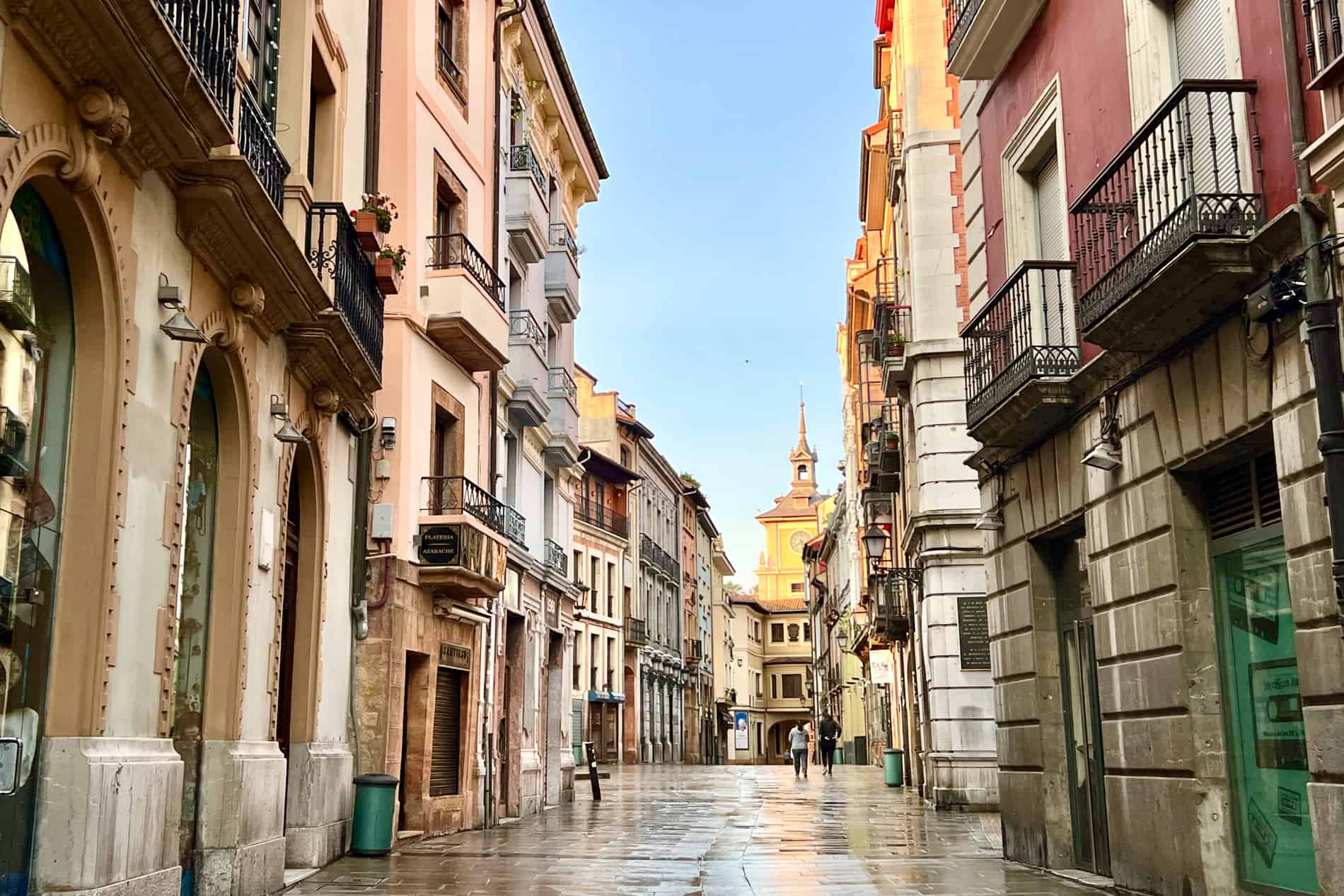
Oviedo, Spain – The Monumental Capital of Asturias
Contents
Oviedo Guide – Things to Know
Here are the things to know from when to go, where to stay and what to see before planning a trip to Oviedo (pronounced Ov-ee-ay-doh).
Is Oviedo Worth Visiting?
Oviedo combines natural landscapes with a millennium of historical and cultural heritage and renowned gastronomy, from stews to sidra (cider). While the regional capital is a natural starting point, the Asturian cities of Avilés and Gijón are also easily reachable within one hour, and the mountainous Picos de Europa National Park in two.
Other points of interest in Northern Spain include the neighbouring province of Castilla y León, whose capital, León is an ideal city to culturally twin with Oviedo.
Best Time to Go to Oviedo
Situated between oceanic and mountainous terrain, the temperature in Oviedo is comfortable year-round.
It means summers are not overbearingly hot (20-30 degrees), and winters are not blisteringly cold (5-10 degrees). Spring and Autumn average 15 degrees, with Autumn the time for the highest rainfall. With coastal cities, village valleys and forested peaks nearby, there are areas of activity in all seasons.
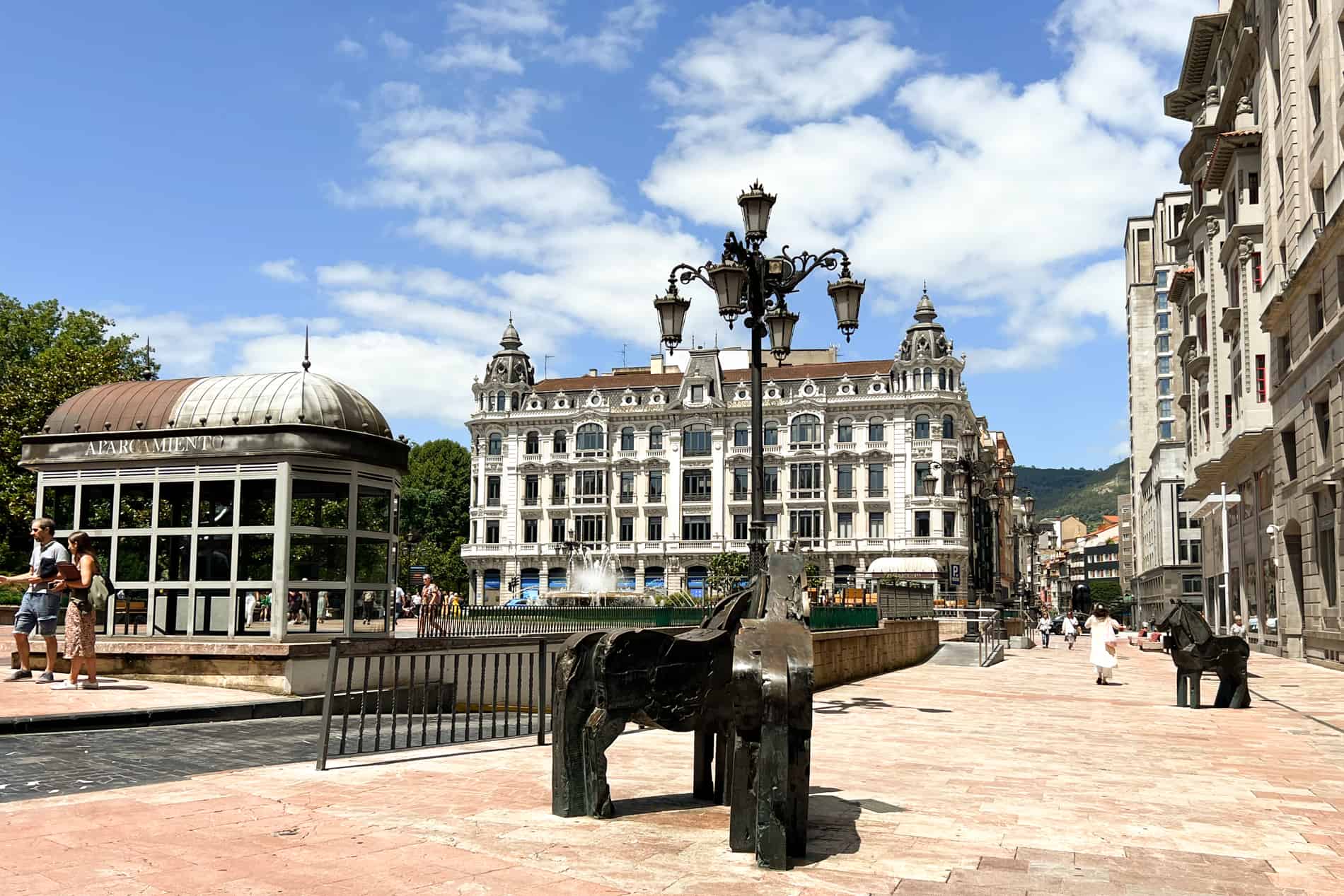
Plaza de la Escandalera in Oviedo, with the ‘Asturcones’ horse sculptures.
How Many Days to Spend in Oviedo City
While many an Oviedo travel guide would tell you this is a day-trip city, I say to grant it more time. Give yourself at least two days to comfortably explore the city and plan for what Oviedo is famous for besides its statues – gastronomic indulgences. For example, you might not want to cram a big lunch and a cider house feast on the same day.
One day in Oviedo isn’t enough. Especially if you spend longer in museums, you’ll want that extra day.

Street life in the classic and colourful Oviedo city.
How to Get to Oviedo
By air
The cities of Asturias in northern Spain – Avilés, Gijón, and Oviedo – can be easily reached from Asturias Airport (OVD), the only international airport in the province with regular Iberia and Vueling flights.
It takes 45 minutes – 1 hour to reach Oviedo from the airport. Despite the airport code, Oviedo is the furthest city away and Avilés the closest. However, regular buses run between the airport and all three cities. You can check departures on the Alsa bus website.
By rail and bus
The extensive Renfe rail service connects Spain, making travel between Asturias quick and easy and connecting to neighbouring provinces and Madrid. The train from Madrid to Oviedo takes around four hours and 30 minutes.
The train from Gijón to Oviedo takes around 25 minutes. There is no direct railway connection between Avilés and Oviedo – you’ll have to take an Alsa bus for the 45-minute journey.
Check out my Renfe AVE guide to train travel in Spain, with information on how and where to book tickets and route tips for city hopping adventures.
Where to Stay in Oviedo
There are dozens of hotels in Oviedo, encouraging longer stays in the city and making a convenient base to explore the nature surrounding it.
My accommodation was Gran Hotel España – a centrally located, modern, mid-budget hotel in Oviedo city close to the Cathedral, Archaeological museum and Cider Boulevard, and a short walk to San Francisco Park. From €60 a night for a double room, including breakfast. Soho Boutique Oviedo has a similar offering, located 300 m from Plaza de la Constitución. Prices start from €80.
A budget option with style is Green Hostel – a modern and minimalist space right in the city, with six-bed dorm rooms and private rooms with ensuite bathrooms. Some rooms have a city view, so it’s worth asking which are available, although you may pay a small premium. Dorm room bed from €20 per night, and a private double from €60. Breakfast is also included.

Oviedo – Origen of the Camino.
Things to Do in Oviedo
A monumental medieval town. Tiled streets with chromatic charm. Treasuries of art and UNESCO World Heritage sites. Oviedo is an urban wonderland for the curious. One of the first cities in Spain to be mostly pedestrianised, it’s a city best explored on foot, and the Old Quarter is where you’ll find most Oviedo attractions.
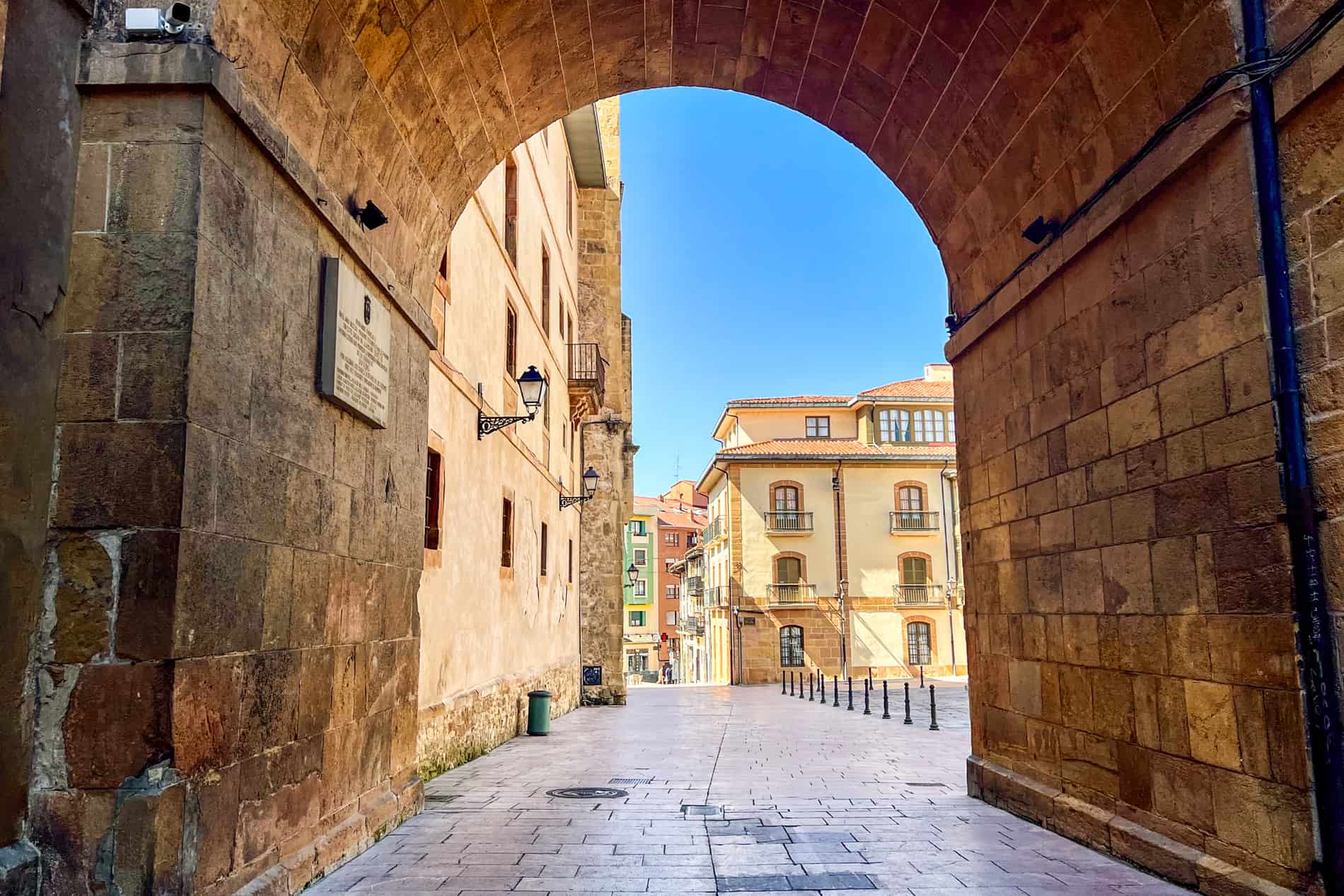
This stone archway leads to Oviedo’s Plaza de Feijoo.
Find the Prettiest Plazas
Plaza Daoiz y Velarde
This rectangular enclosure next to Plaza del Fontán and its covered market, El Fontán, is known for its outdoor market. Still, one of the most photogenic features of Plaza Daoiz y Velarde is the building arcades and, most notably, the bright blue and yellow painted building of the Casa Ramón restaurant – a striking picture next to the pastel hues of its neighbours.
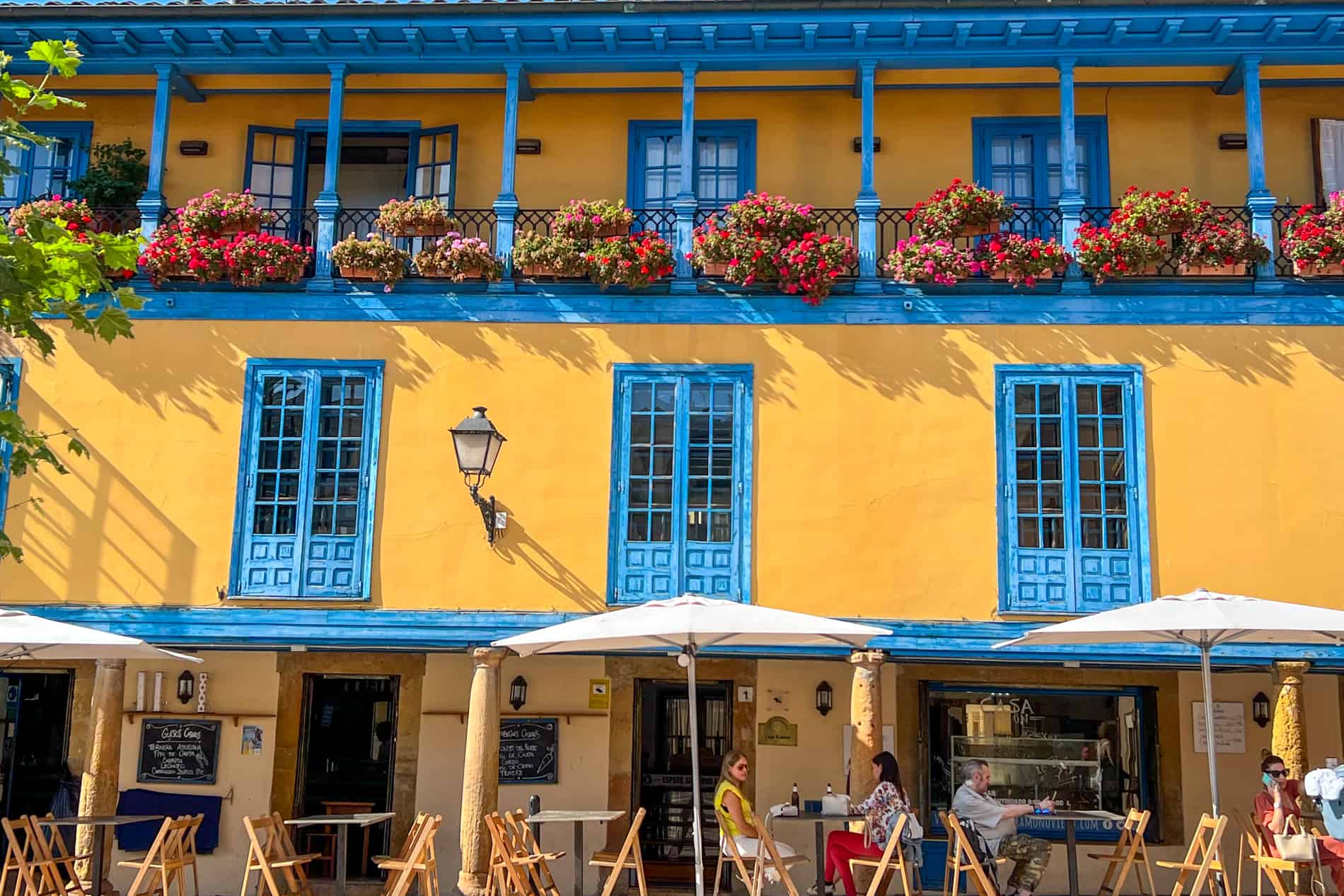
The most beautiful building on Plaza Daoiz y Velarde.
Plaza de la Constitución
The official and most important square in the city, Plaza de la Constitución is where you’ll also find Ayuntamiento de Oviedo (Oviedo’s Town Hall) and the Iglesia de San Isidoro el Real (Church of San Isidoro El Real). The central arch of the Town Hall building – built in 1622 using parts of the old medieval wall – marks the boundary between the old and new sectors of the city. Walk through the arch on the Calle Cimadevilla, and you’ll enter the Old Quarter.
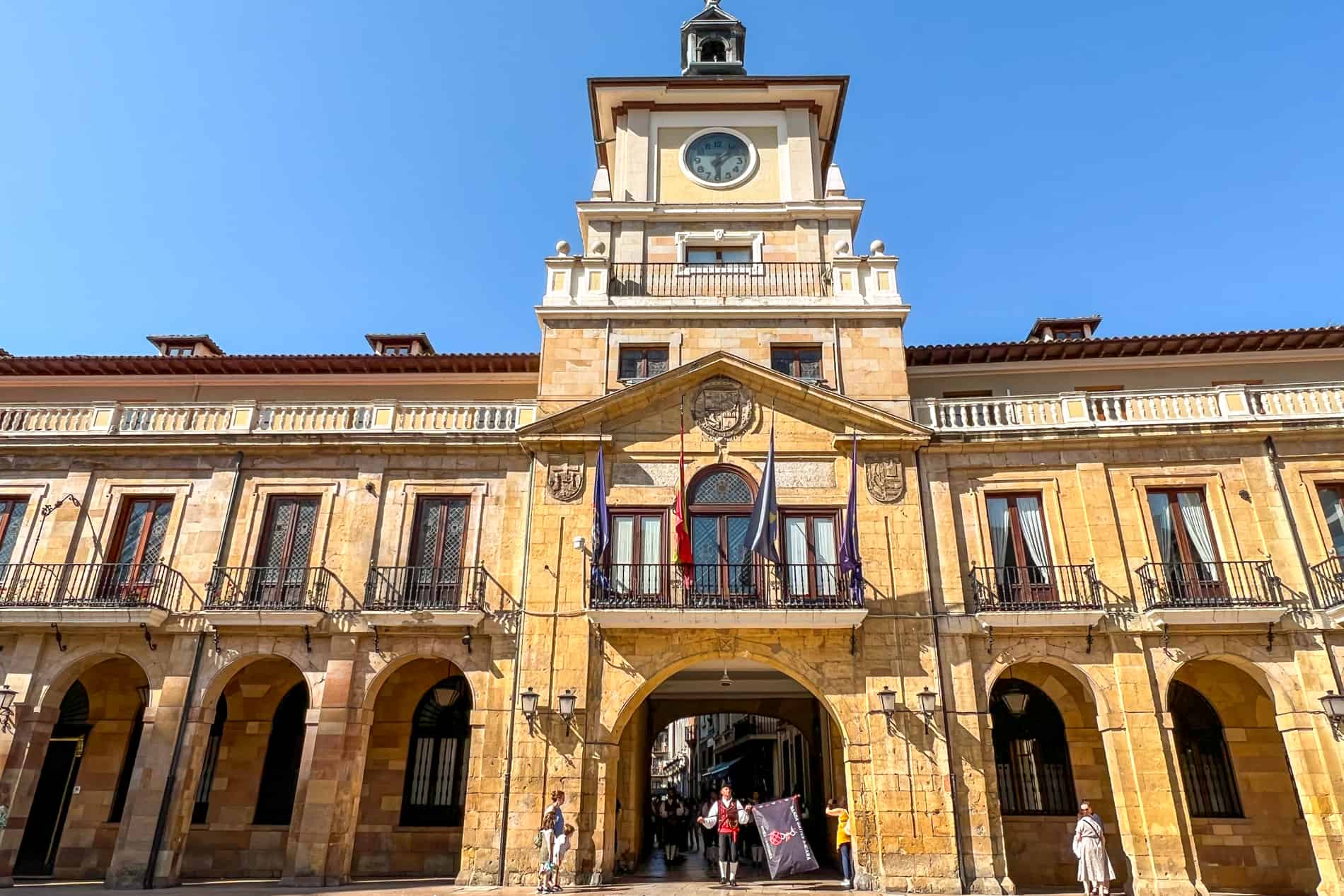
Ayuntamiento de Oviedo (Oviedo’s Town Hall), incorporates parts of the old Roman wall.
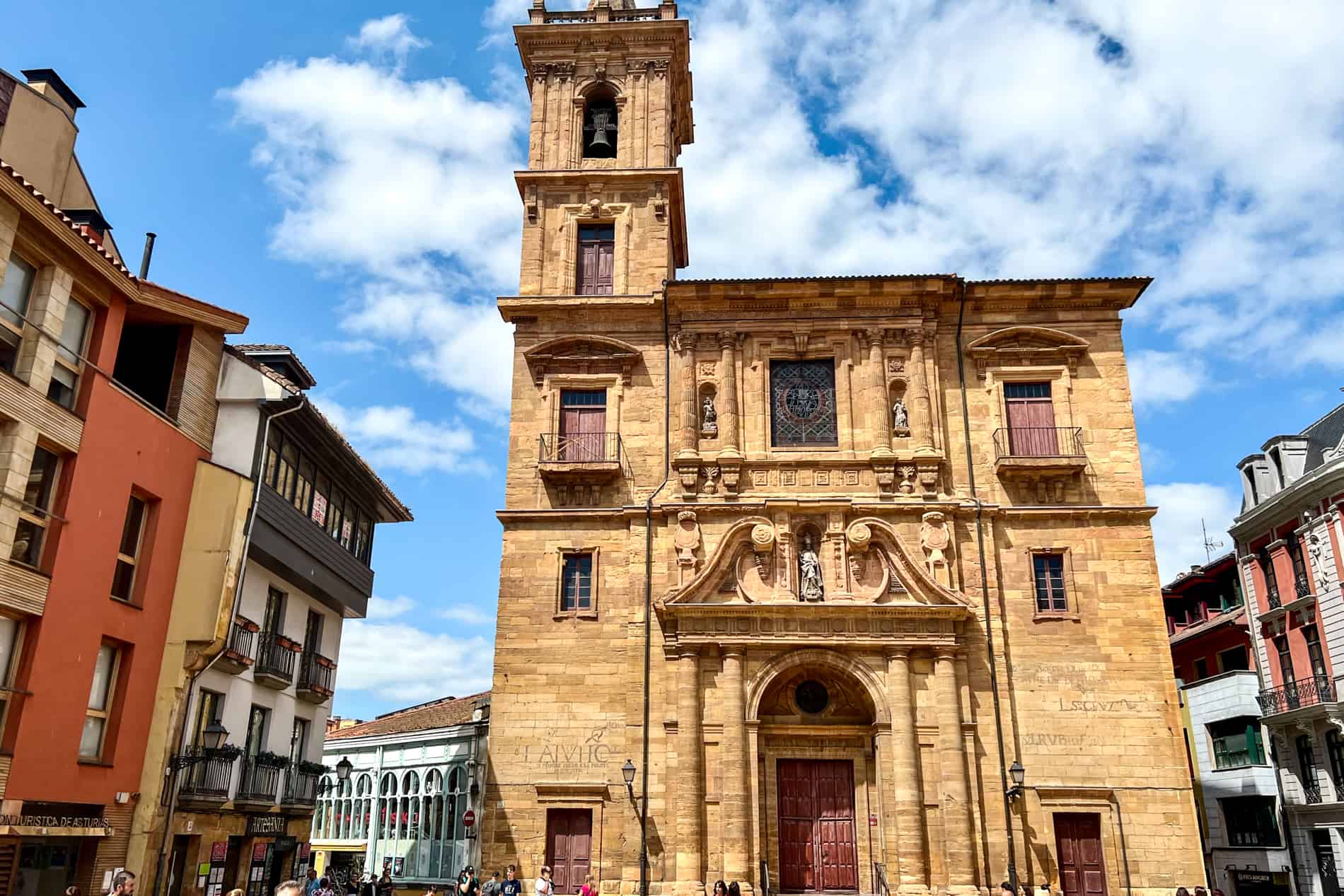
Iglesia de San Isidoro el Real stands out amongst more modern buildings in Plaza de la Constitución.
Plaza de la Catedral
Plaza de la Catedral is where you’ll find the city’s architectural masterpiece. The square’s original name, Plaza Alfonso II el Casto, is named after the King who ordered the construction of the San Salvador Cathedral in 812. It’s a symbolic square at the heart of the Original Way of St. James pilgrim route as people continue to pass through today on their journey. It’s also where you’ll find the “La Regenta” statue and Museum of Fine Arts.

The city’s masterpiece is the Basilica del Salvador of Oviedo.
Plaza Trascorrales
Hidden behind a cluster of buildings, you’ll know when you’ve stumbled upon Plaza Trascorrales when you enter this compact square filled with colour and al fresco café culture. Here you’ll find one of Oviedo’s best statues of a milkmaid and her donkey.
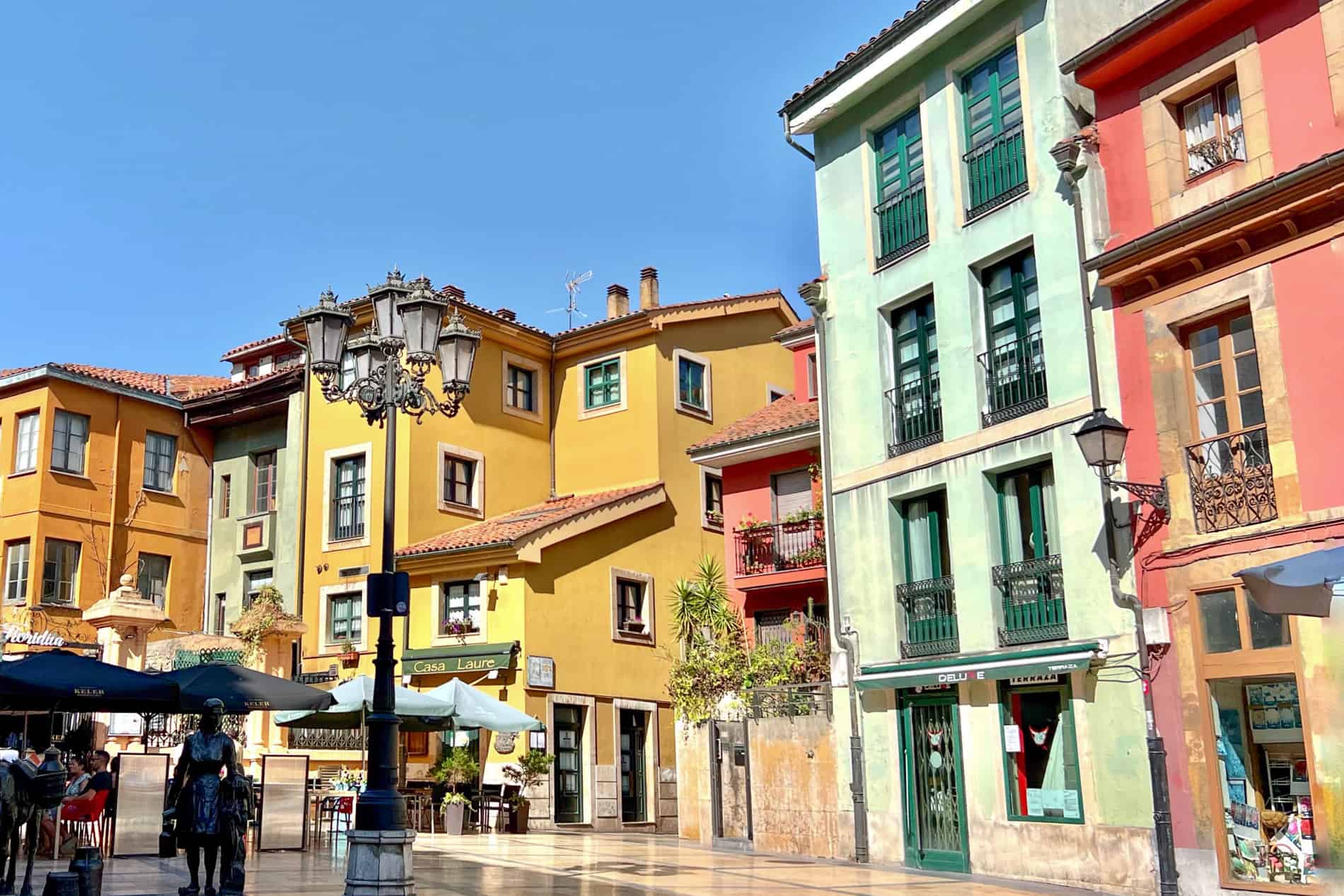
The pantones of Plaza Trascorrales.
Plaza del Paraguas
In a more edgy, bohemian corner of Oviedo, I was drawn to Plaza del Paraguas for the giant metal umbrella – a popular meeting spot in the city lined with bars. In the morning, it’s a blissfully quiet corner of the city, bathed in a golden glow.
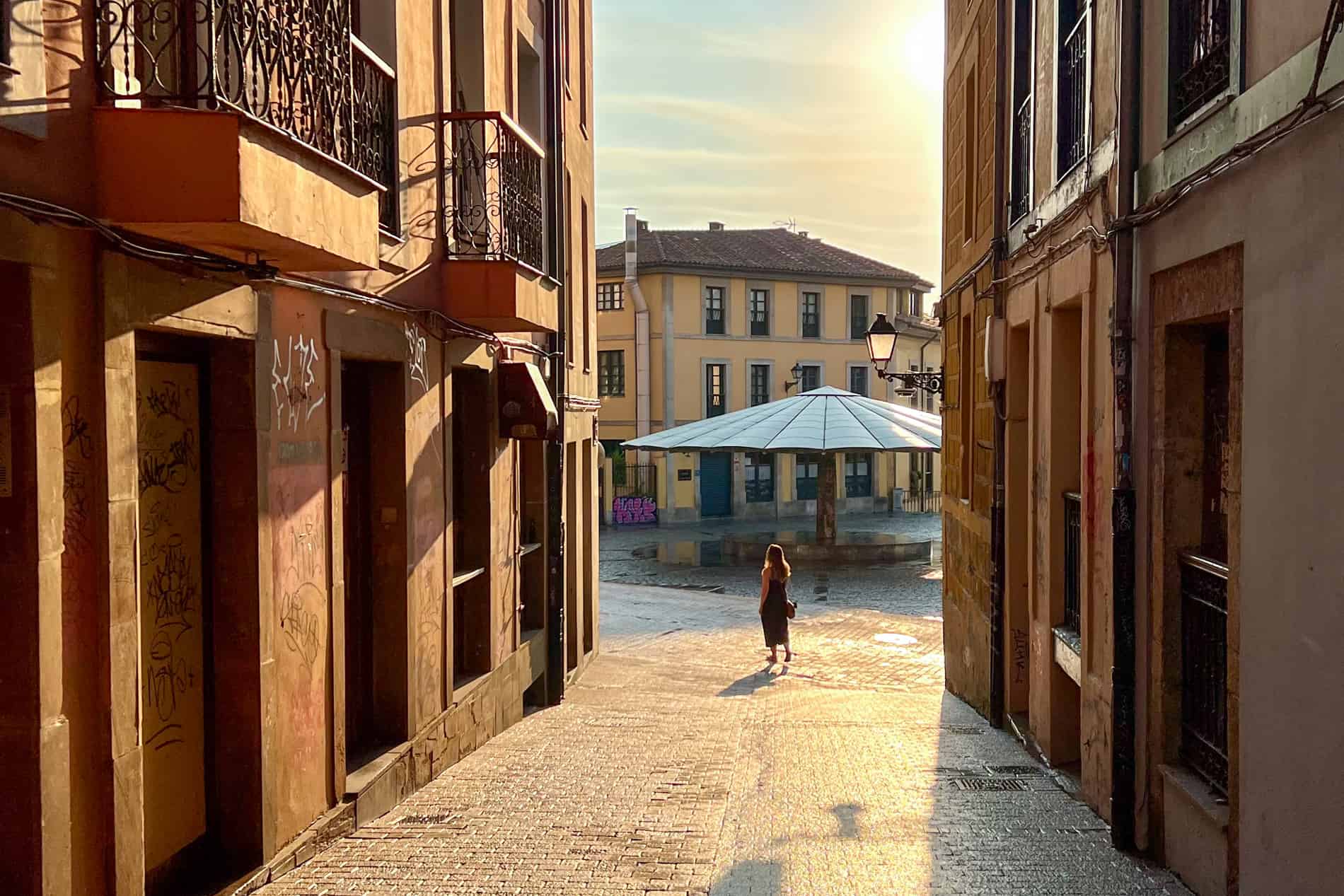
Finding the giant umbrella structure in Plaza del Paraguas.
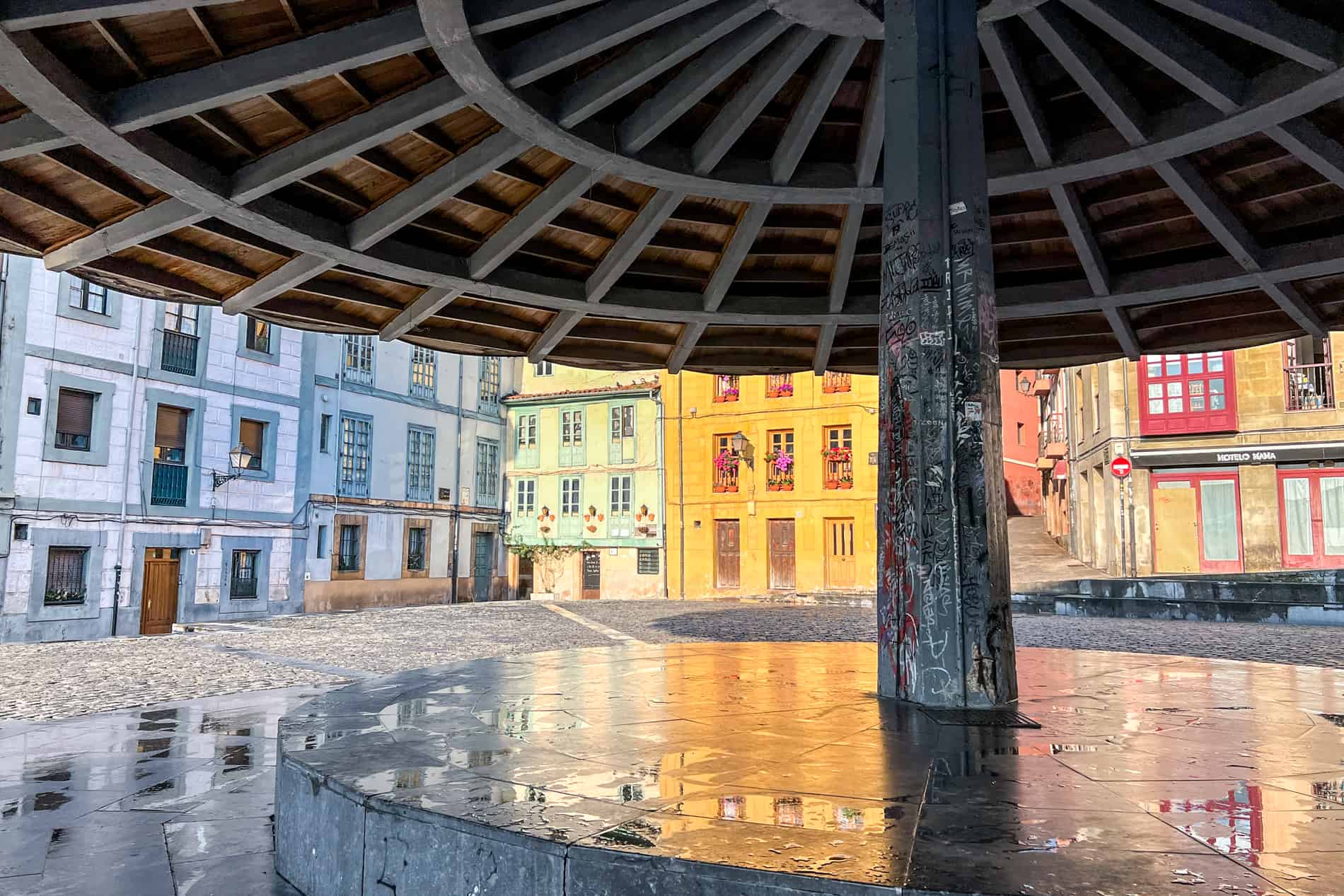
The umbrella is a popular meeting spot in Oviedo.
See Why Oviedo is the City of Statues
Oviedo is full of statues and sculptures, turning the city into an open-air museum with over 100 works of art in its streets, squares, and parks. Here’s a pick of 10 well-known statues to seek out on your city walk.
El Regreso de Williams B. Arrensberg (The Return of Williams B. Arrensberg) is also known as ‘The Traveller’ – a man in a long coat leaning against his suitcase and looking toward the Cathedral. By Eduardo Úrcula, Plaza de Porlier.
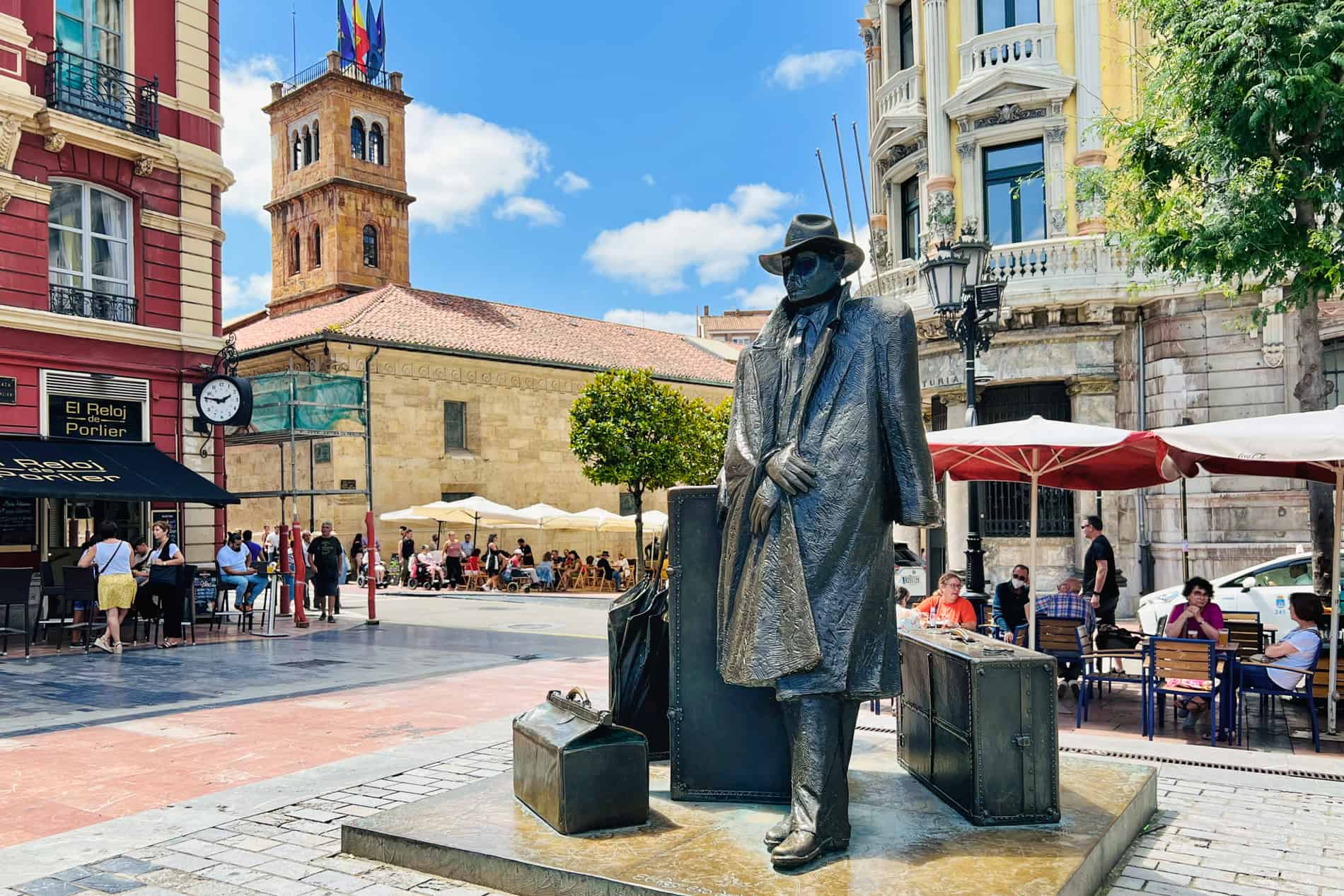
El Regreso de Williams B. Arrensberg.
La Regenta is a tribute to the heroine of an Oviedo based novel by writer Leopoldo Alas-Clarin. By Mauro Álvarez Fernández, Plaza de la Catedral.
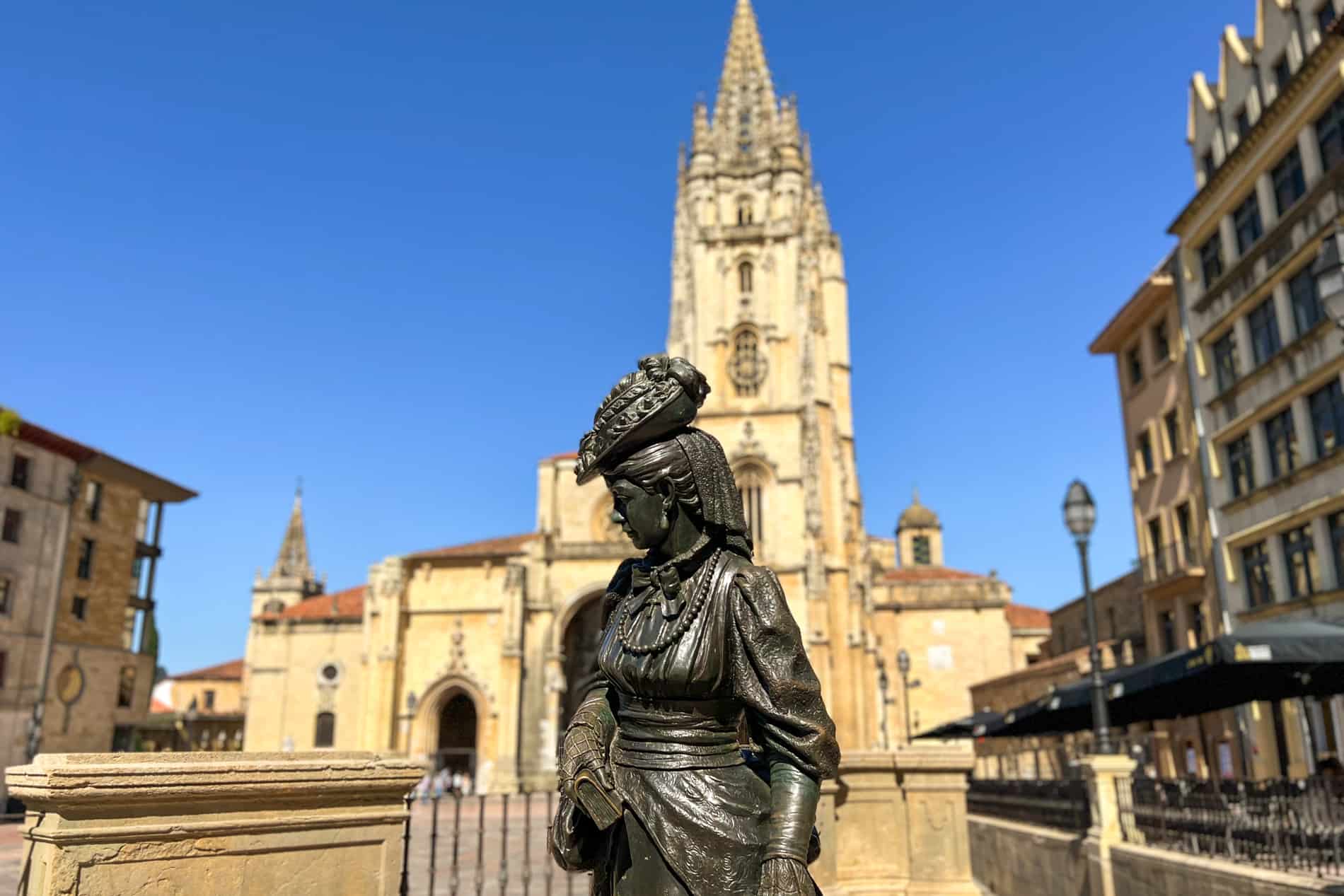
La Regenta.
Culis Monumentalibus is a 4-metre high, black tarnished bronze disproportioned pair of buttocks. You can’t miss it. By Eduardo Úrcula, Calle Alonso de Quintanilla outside Teatro Campoamor.
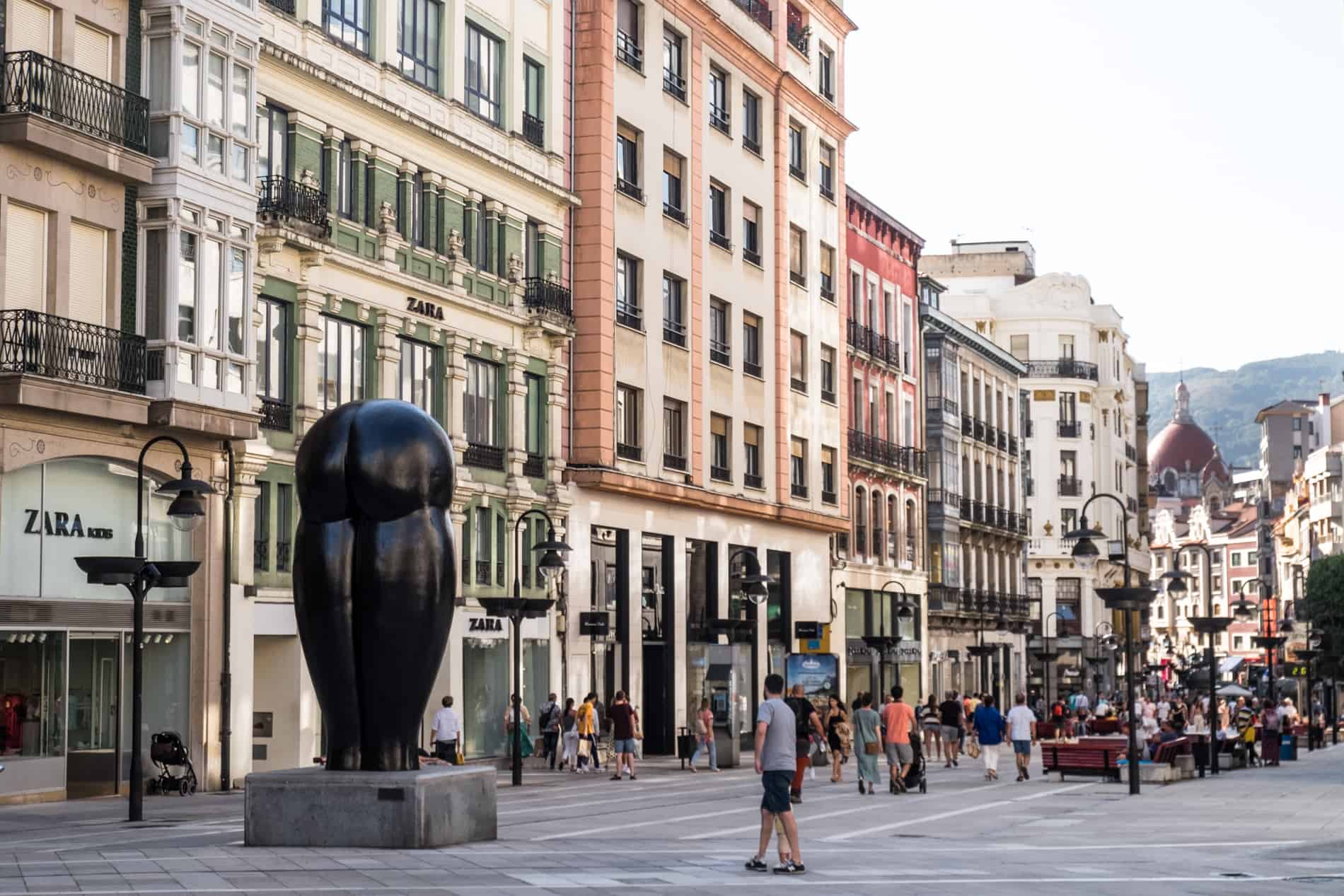
Culis Monumentalibus.
La Lechera shows a milkmaid with her donkey honours the women who would come to Oviedo to sell milk. By Manuel García Linares, Plaza Trascorrales.
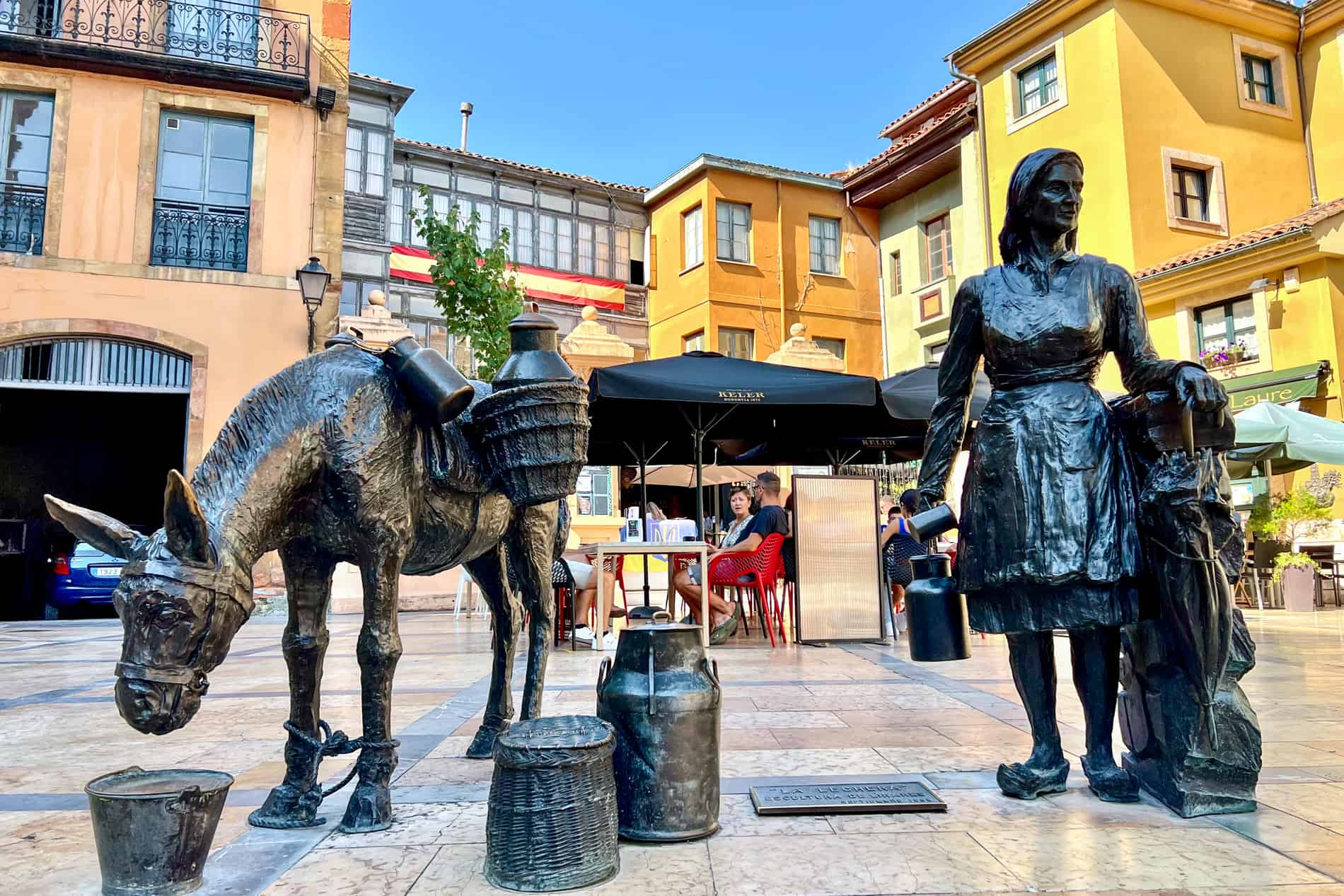
La Lechera.
Las Vendedoras del Fontán (the sellers of Fontán) represents the market history of this square. By Amado González Hevia, Plaza Daoiz y Velarde.
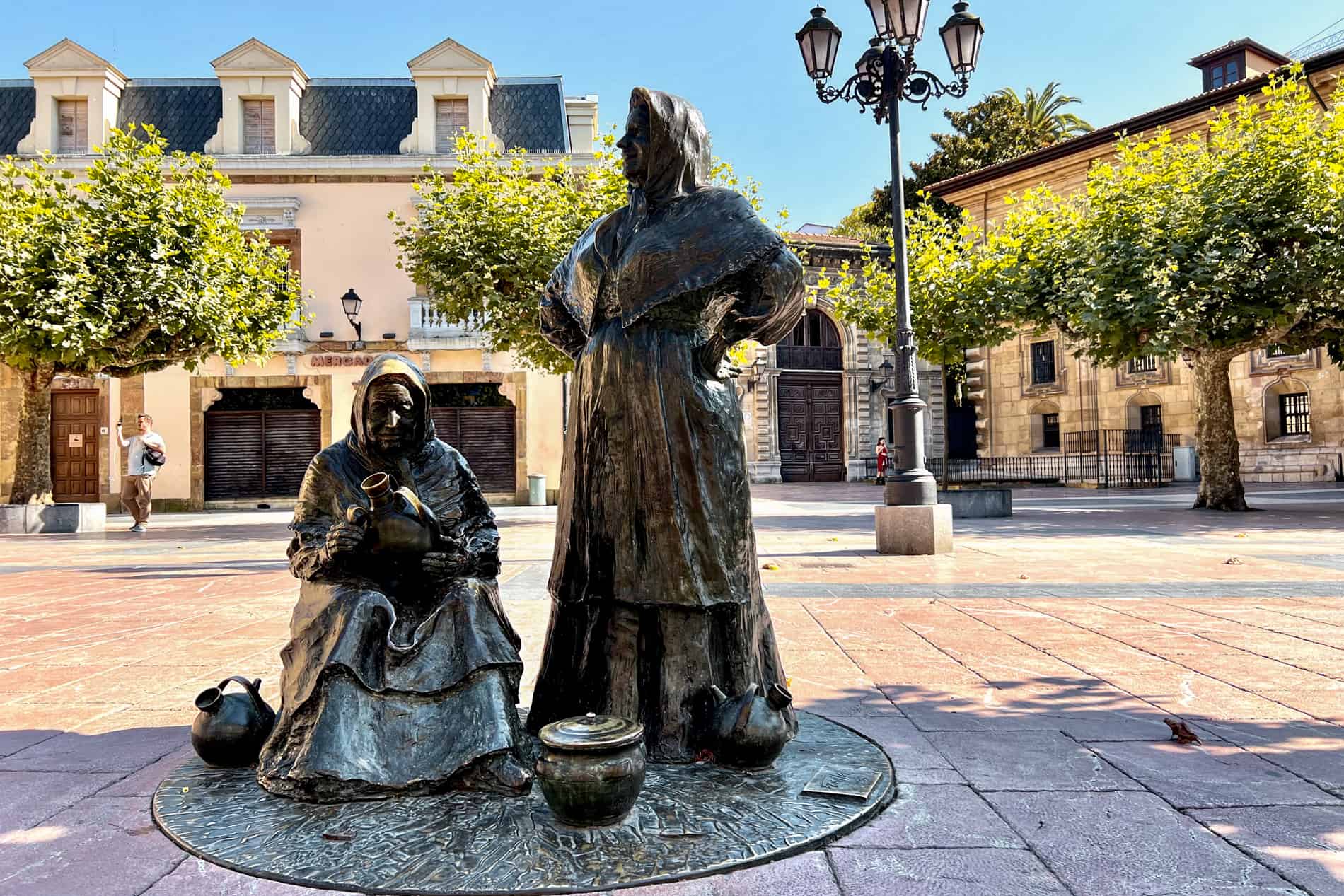
Las Vendedoras del Fontán.
La Bella Lola (the beautiful sorrow) shows a lady on the bench looking towards the sea, watching loved ones leave after saying goodbye. By Carmen Fraile, Plaza del Fontán.
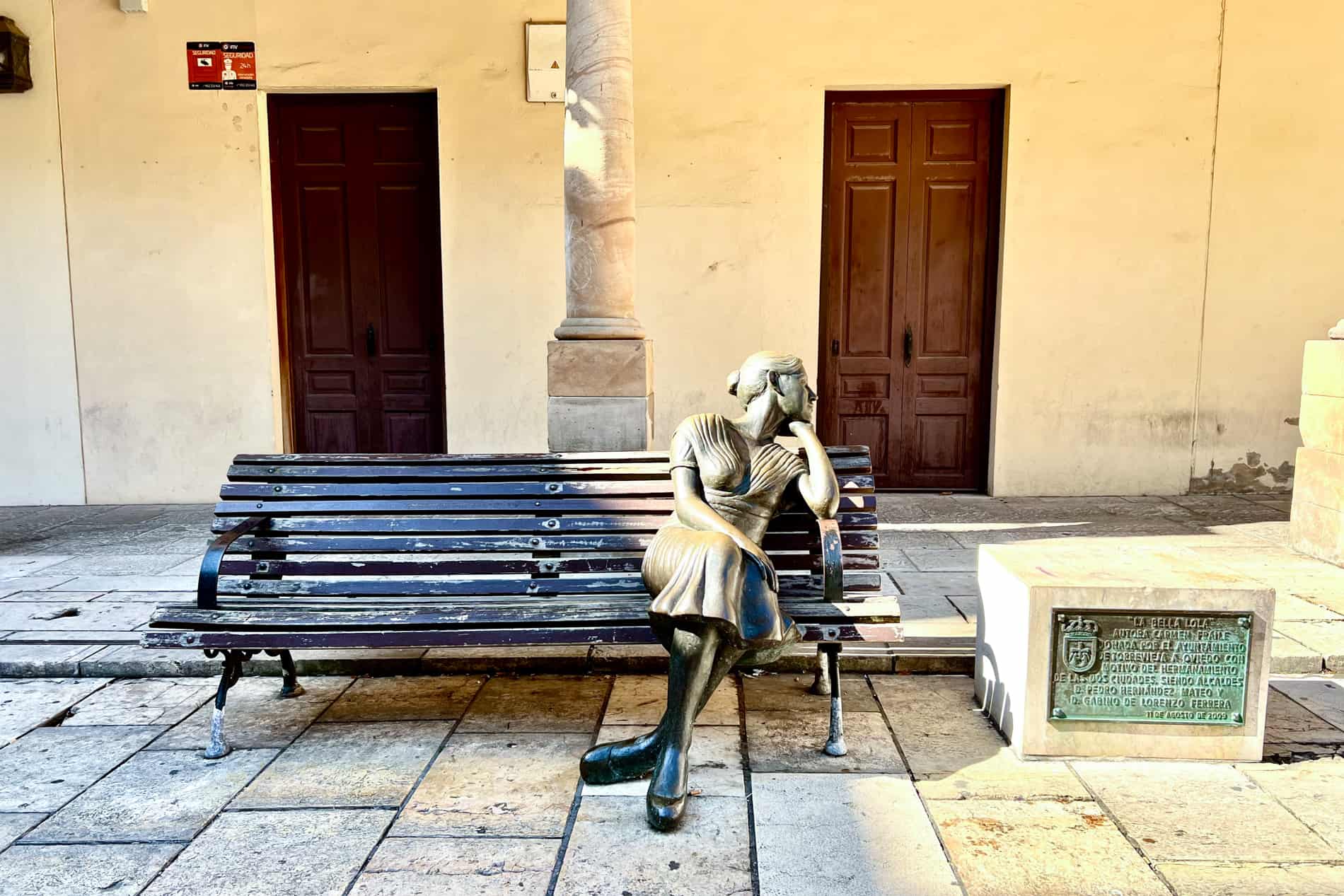
La Bella Lola.
El Vendedor de Pescado (the fish seller) shows a squatting man with his catch as he awaits a sale. By José Antonio García Prieto, Plaza Trascorrales.
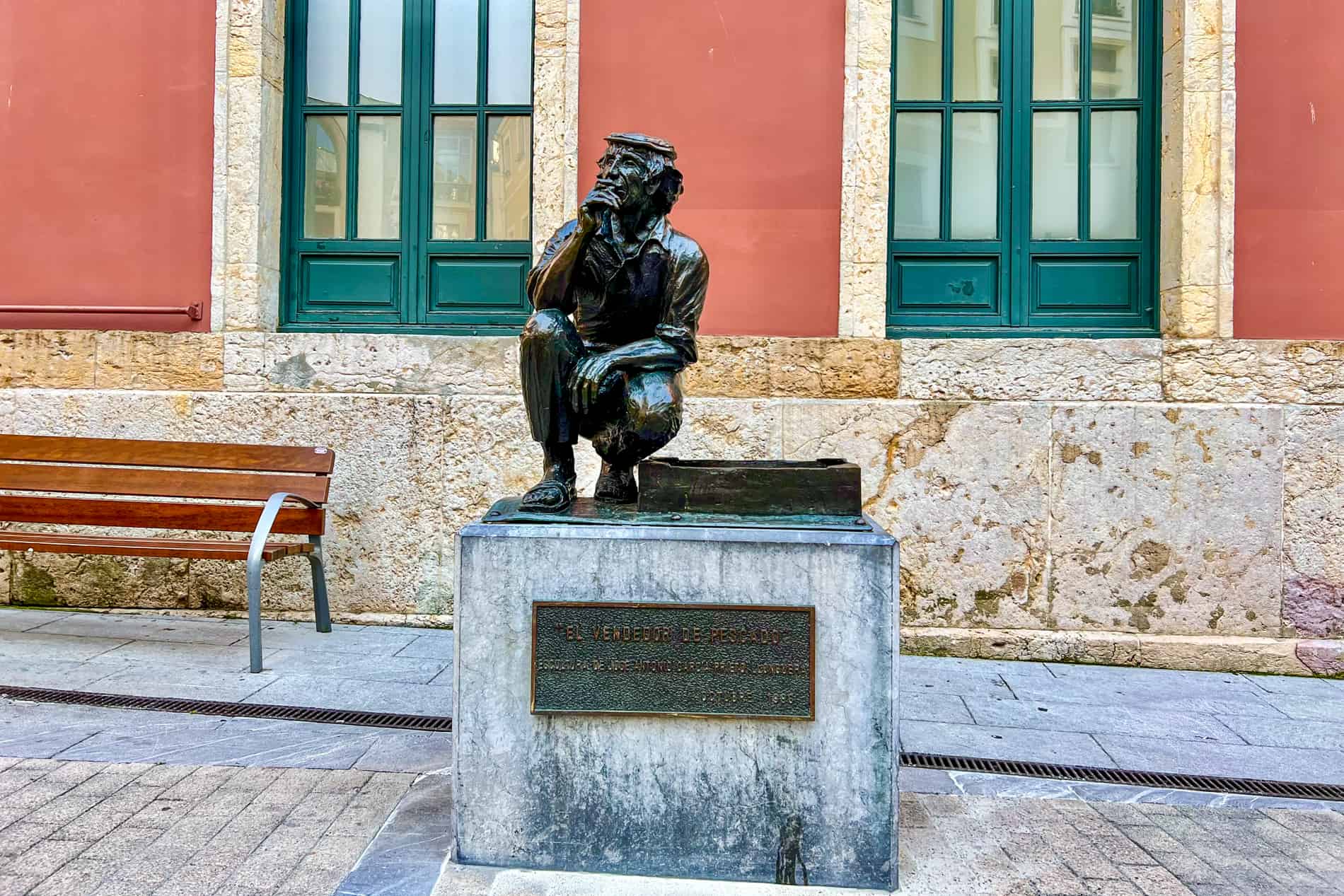
El Vendedor de Pescado.
Mafalda is an Argentine satirical cartoon character popular in Spain, and this statue on a bench in San Francisco Park honours the creator, Quino, for his contribution to the arts.
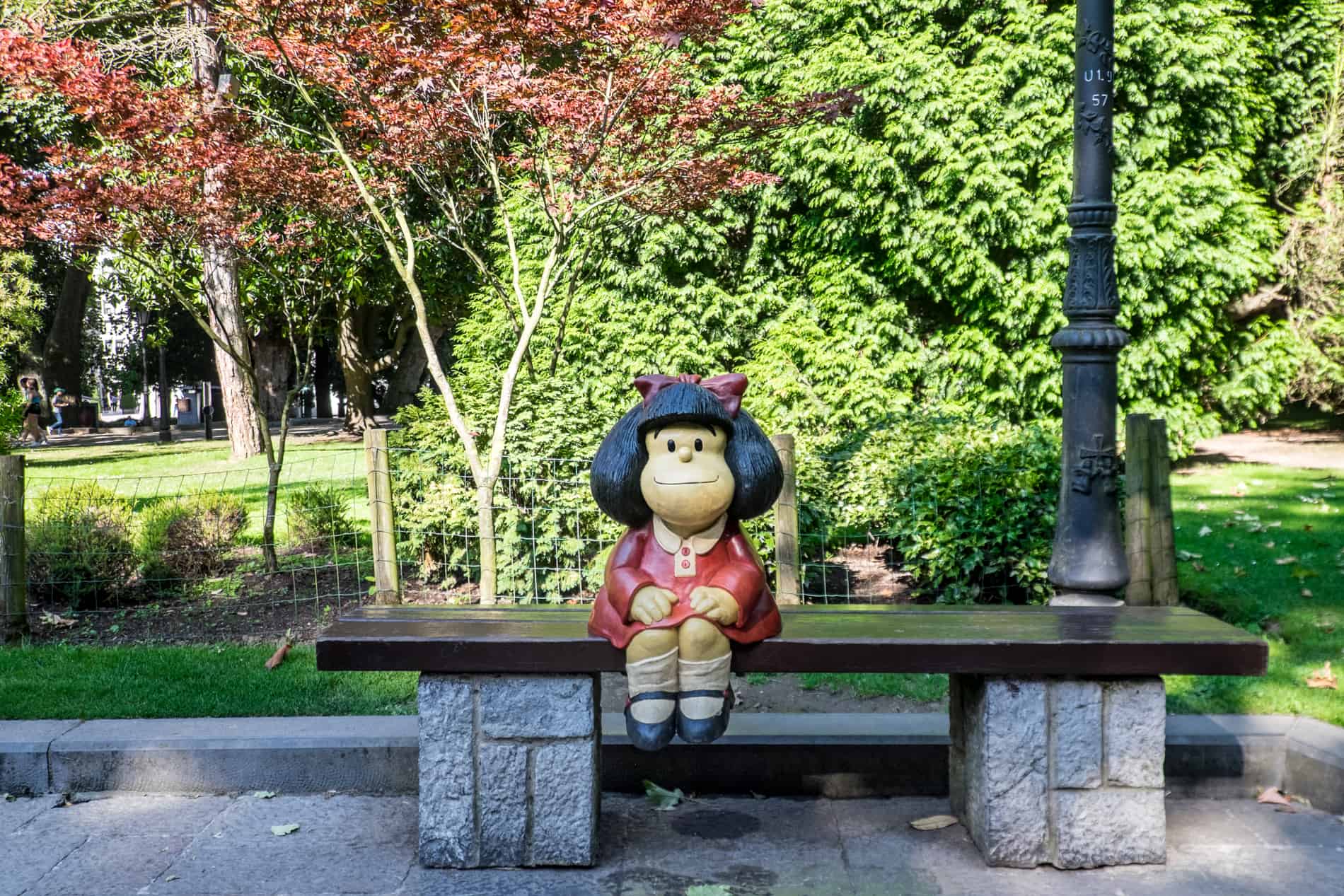
Mafalda sitting on the bench in San Francisco Park.
La Maternidad (Maternity), also known as ‘La Gorda’, represents motherhood and shows an oversized and disproportionately shaped woman and her child. By Fernando Botero, Plaza de la Escandalera.
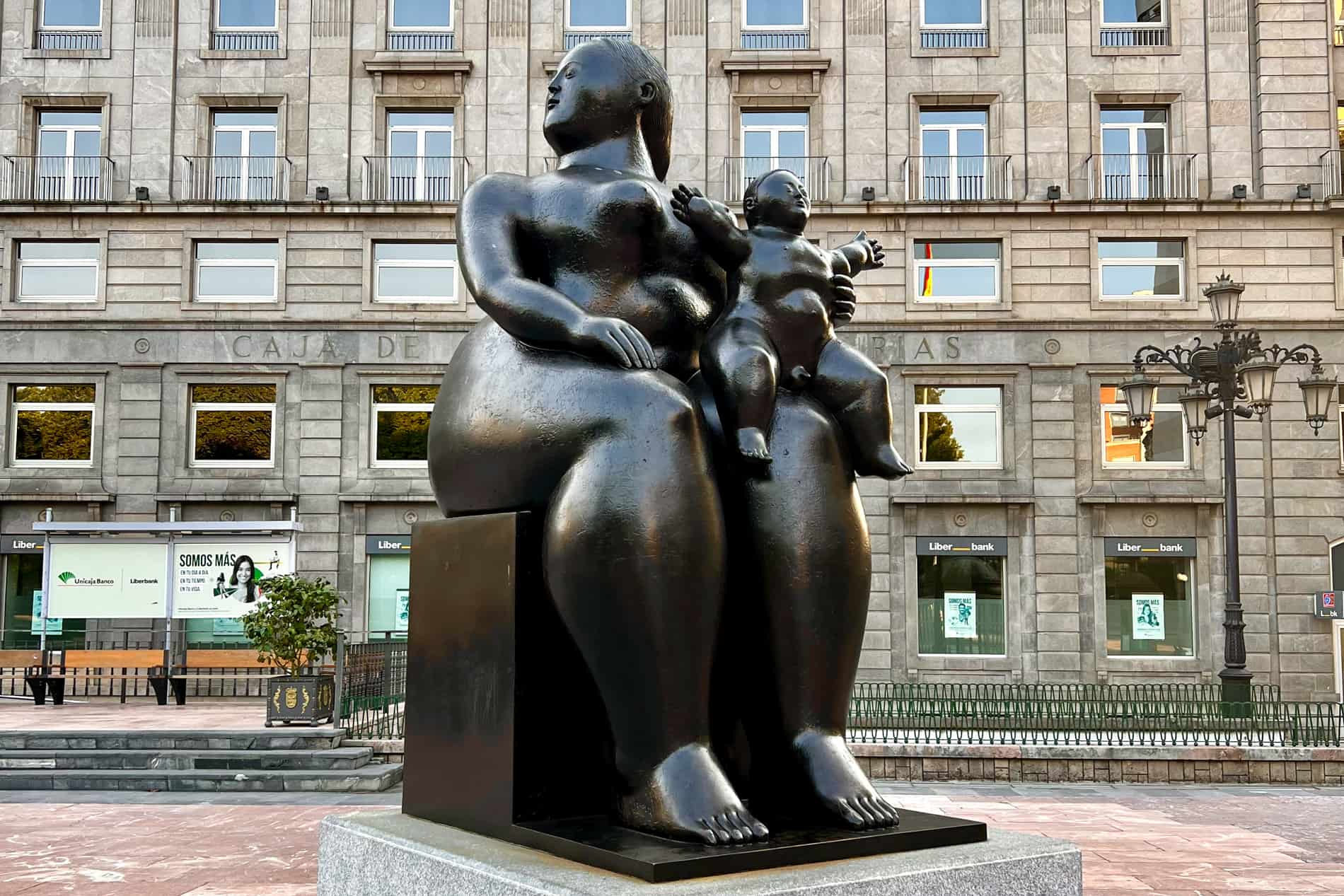
La Maternidad.
Casal is life sized statue of Asturian singer and 80s pop icon, Tino Casal. By Anselmo Iglesias Poli, Calle Palacio Valdés.

Casal.
Admire the UNESCO Pilgrim Cathedral – Basilica del Salvador
The 13th-century single-towered Gothic structure of the Basilica del Salvador took 300 years to perfect and is one of the foundational Oviedo and Asturias tourist attractions. The original cathedral site was founded by King Fruela I of Asturias in 781, and his son, Alfonso II of Asturias, enlarged it in tribute to his pilgrimage. Legend has it that the tomb of St. James was found in Iria Flavia (Padrón, Galicia) in 813, and King Alfonso II travelled from Oviedo to see it for himself – making him the first-ever pilgrim.
It was the start of a journey that came to be known as The Original Way of St James (The Primitive Way) that today begins in Oviedo – a 320km journey considered the oldest pilgrimage route. Following a similar trail, the Northern Way of the Camino de Santiago passes through Oviedo – an 800km journey through the Basque region, Asturias and Galicia.
Visit Oviedo Cathedral, with its gothic altarpiece, vaulted ceilings and intricate carvings – it’s considered the third most beautiful cathedral in Spain. The pre-Romanesque structure was the Chapel of King Alfonso II, known as the Holy Chamber – home to the King’s collection of prized Christian relics, including the Holy Shroud of Jesus Christ.
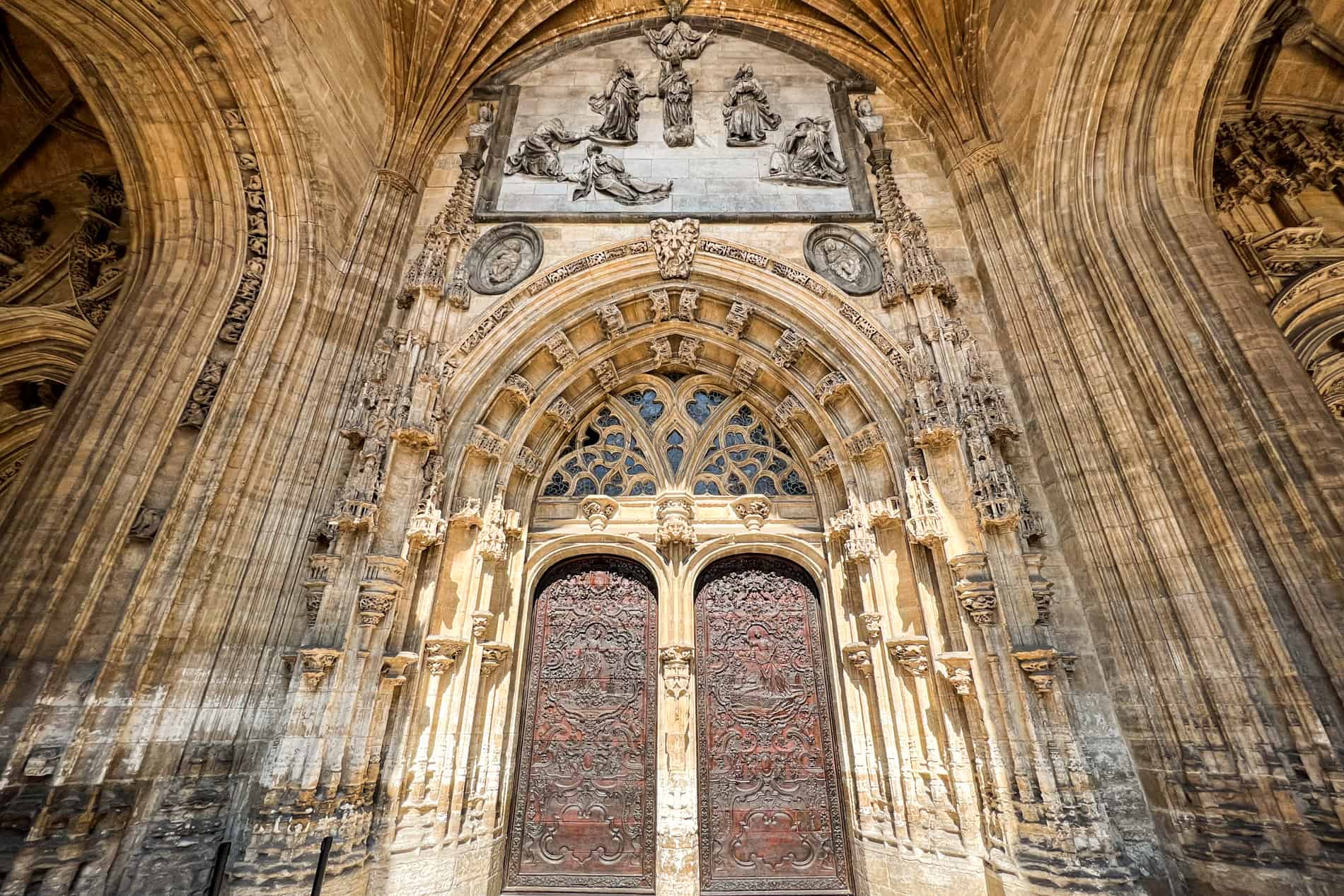
The magnificent entrance of the Basilica del Salvador.
Listen to Traditional Gaita Asturiana Bands
If you visit on the weekend, you might hear the skirl of bagpipes reverberating throughout Oviedo’s old town. Follow the sound, and you’ll be lucky to stumble upon a unique tradition. During a visit to the Plaza de la Catedral, we came across a band in folk dress performing with drums and Gaita Asturiana. This type of bagpipe is native to Asturias, and its pitch is a little different to what you might know from Scotland since it only has two pipes instead of five.
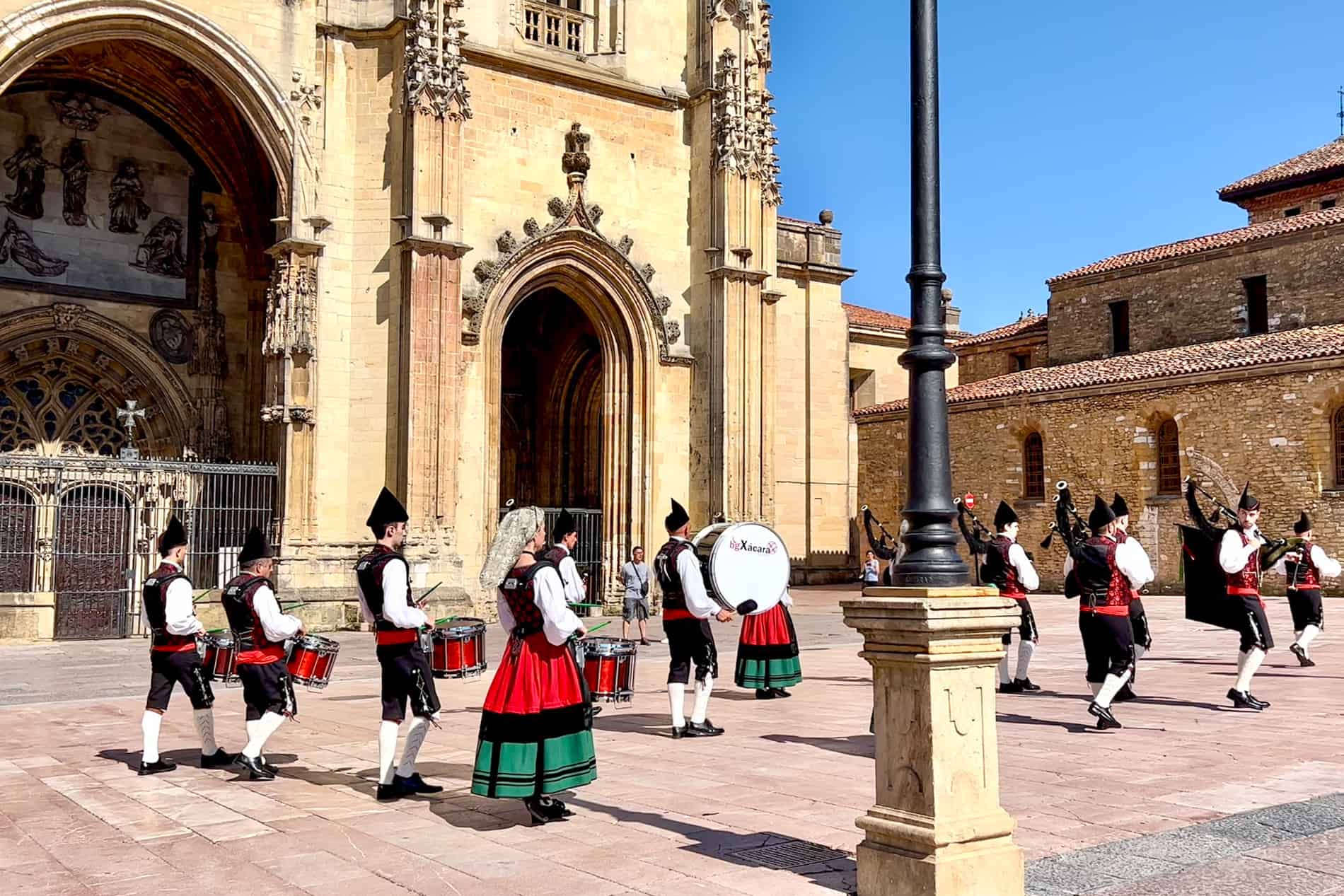
Hear the sounds of Gaita Asturiana on the weekends in Oviedo.
Relax in the Urban Park, Campo de San Francisco
The former 13th century San Francisco Convent garden, Campo de San Francisco (San Francisco Park), is a botanical hideaway just outside of the old town in Calle Uría – the commercial area of Oviedo. It’s filled with pathways, ponds and peaceful corners, statues, and the Romanesque stone archway ruins of the old San Isidoro Church. I enjoyed my 8 AM morning walk through this shaded haven just as much as I enjoyed visiting during the day when people queue to get their nostalgic photos with Mafalda and fill the park with childlike happiness.
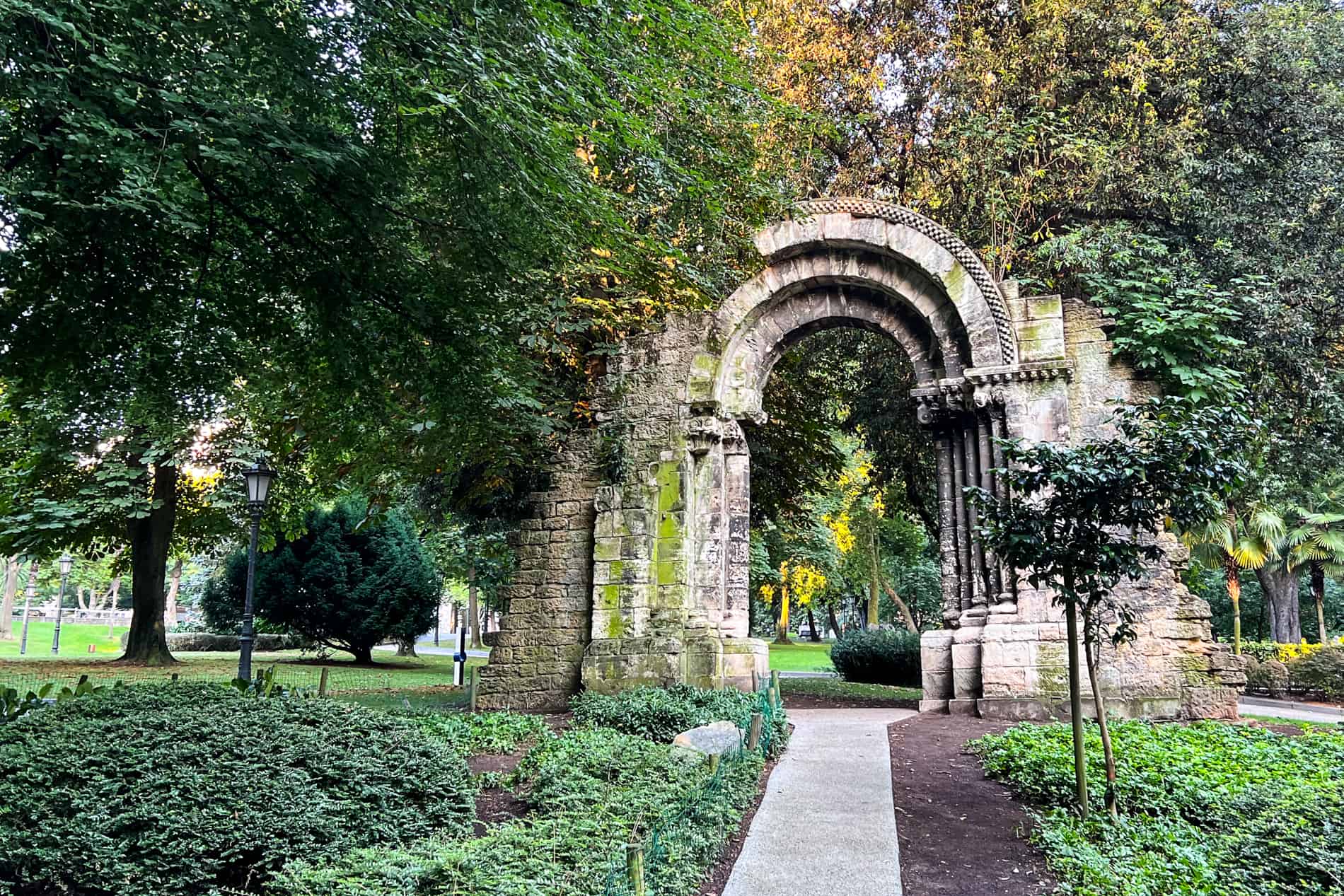
The foliage of Campo de San Francisco grows around the Romanesque stone archway of the old San Isidoro Church.

The La Torera statue in San Francisco Park of photographer, Josefa Carril, who lived in Oviedo.
Visit Oviedo’s Renowned Museums
Oviedo’s rich heritage is curated within its archaeological and art museums – the Archaeological Museum and Fine Arts Museum are considered the most renowned. Not only are the collections contained within of significance, but the structures themselves are of historical value.
Museo Arqueológico de Asturias. The archaeological museum of Asturias houses collections that take you through the timeline of Asturian heritage and Oviedo’s history from the prehistoric to the Roman and Middle Ages eras. Even if you don’t spend long browsing the exhibitions, walk through the impressive Renaissance cloister – this structure was once the original Benedictine convent of Saint Vincente from the 8th century.
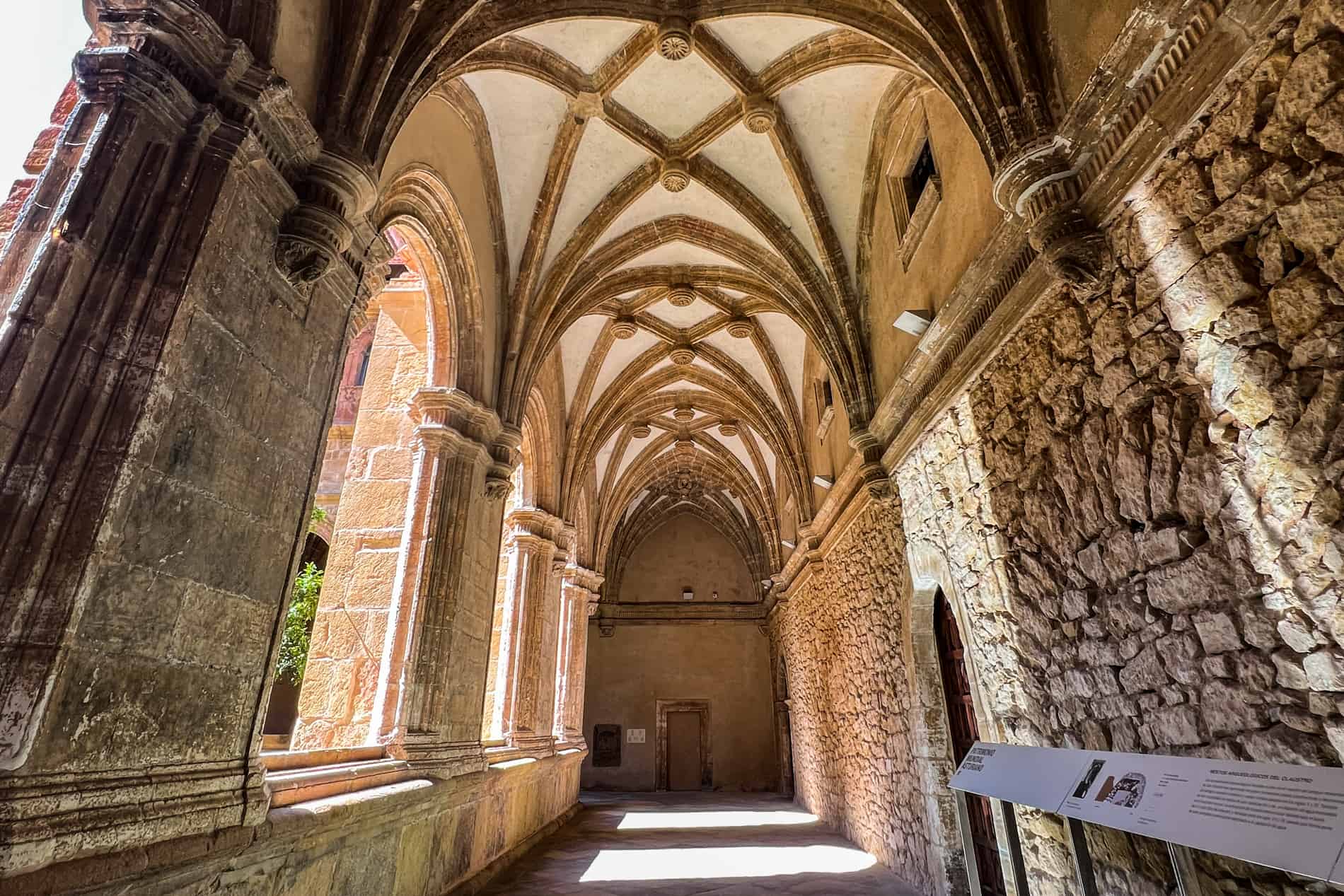
The stone-walled, vaulted ceilings of the cloister inside the Museo Arqueológico de Asturias.
Museo de Bellas Artes de Austurias. Oviedo’s Museum of Fine Art is one of the leading art galleries in Spain, housing an extensive collection of around 10,000 works of art from the past 700 years that include Asturian artists alongside priceless Goyas, Picassos and Dalis. The building has great architectural value, comprised of the 17th-century Portal House, 18th-century Velarde Palace and a 2015 extension that granted it the ‘RIBA Award for International Excellence’.
Marvel Medieval UNESCO Pre-Romanesque Monuments
While there are 15 preserved Pre-Romanesque structures in Asturias, only six make up a collection given UNESCO World Heritage Site distinction in 1985. You can find five in Oviedo. A medieval design style influenced by the detailed frescos and sculpture styles of Christianity, these buildings are seen as the rare art of the Asturian monarchy – an architectural characteristic that flourished during the 200 years of the monarchy (722-910).
Inside the city is The Holy Chamber de Oviedo and the Fuente de Foncalada (Foncalada Fountain). Just 3 kilometres on foot from the centre of the city, on the gentle slopes of Mount Naranco, you can visit three other significant 9th-century monuments.
Iglesia de Santa Maria del Naranco is a palace, on southern slope of Naranco, built 842.
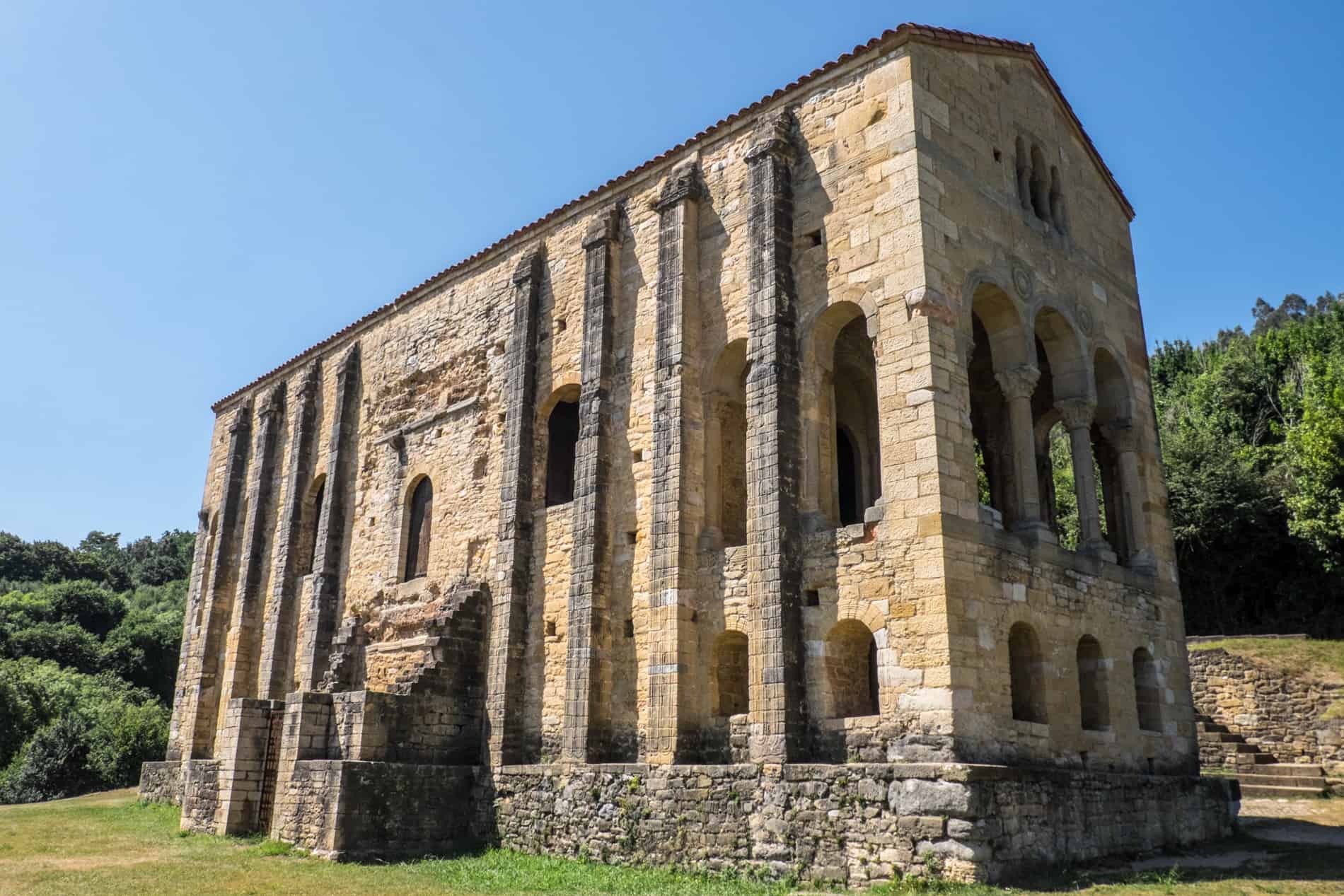
See Iglesia de Santa Maria del Naranco, three kilometres form the centre of Oviedo.
San Julián de los Prados is the oldest and largest of the churches, but San Miguel de Lillo was part of the palace complex. New features of its construction in the 11th century were made by incorporating old elements, which you can spot on the exterior walls. The Frescos inside of acrobats symbolise those not conforming and therefore being sinful.
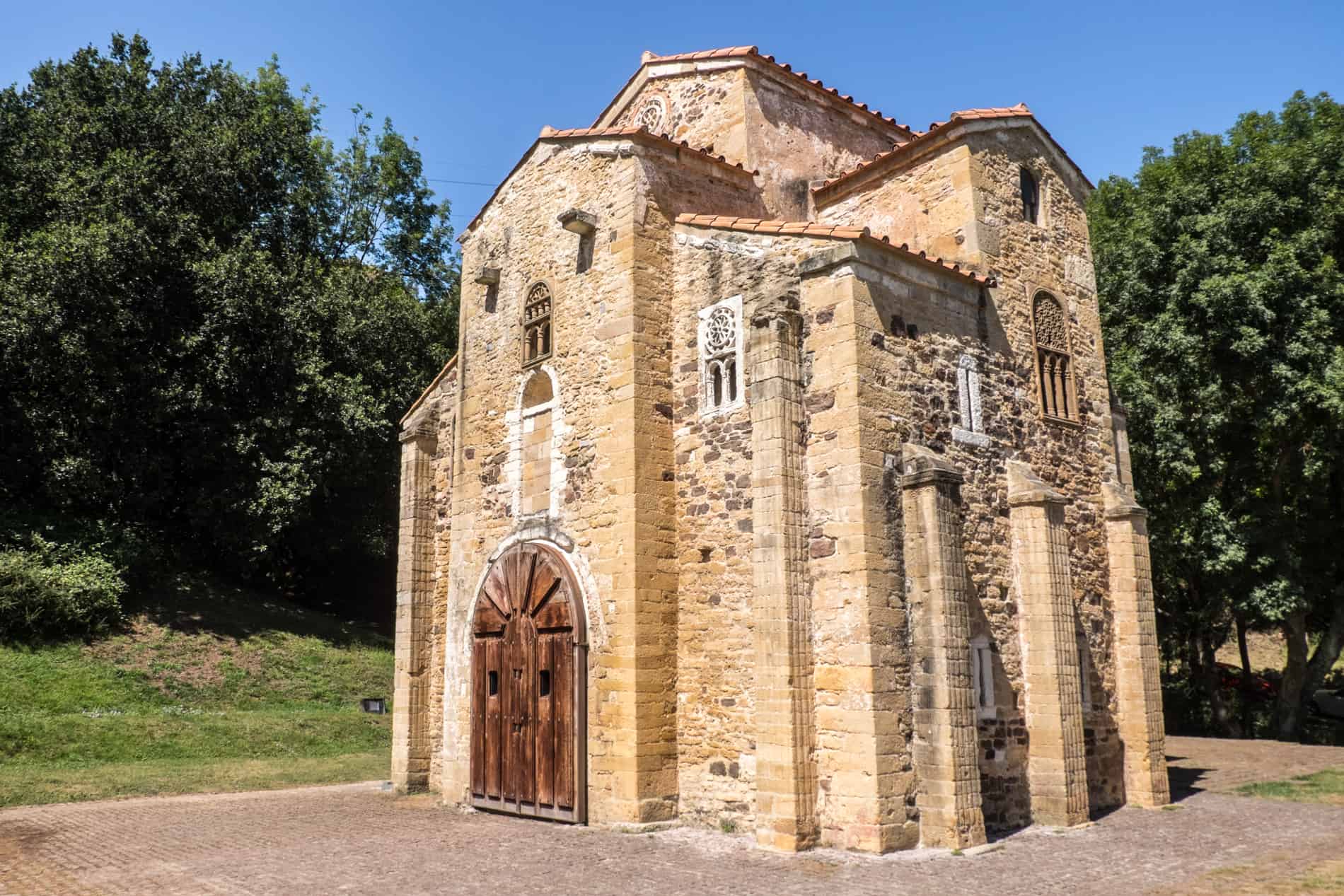
Visit San Miguel de Lillo, once part of the palace complex on the hill.
Gastronomy in Oviedo – Where to Eat and Drink
Gastronomy is a big deal in Asturias. So much so that its regional food and drink produce is as revered, celebrated, awarded, and protected as its historical landmarks and environmental spaces. The latter provides the perfect terrain and fertile lands between the Cantabrian sea and the mountainous meadows to farm and cultivate such delicacies.
Six products of the Principality have received the Protected Designation of Origin (PDO) stamp: Asturian cider, Cangas wine and the four kinds of cheese: Cabrales, Gamonéu, Casín and Afeuga’l pitu. Asturian beef, Chosco de Tineo (smoked preserved sausage) and the Faba de Asturias (white fava bean) have Protected Geographical Indication (PGI).
Ready to work up an appetite on your Oviedo visit? Here’s where to try the famed foods of Asturias.
Shop Local at Mercado El Fontán
The medieval market morphed into a covered food market over the centuries, remaining a fixture of the city. Mercado El Fontán is where the locals stock up on cured meats (like Jamon), dairy (especially cheese), fresh fish, seafood, fruits and vegetables. Browse 2,000 square metres of stalls showcasing local delicacies – it’s hard to leave empty-handed. The busiest days are Thursday, Saturday, and Sunday, when the region’s farmers come to sell the latest products.
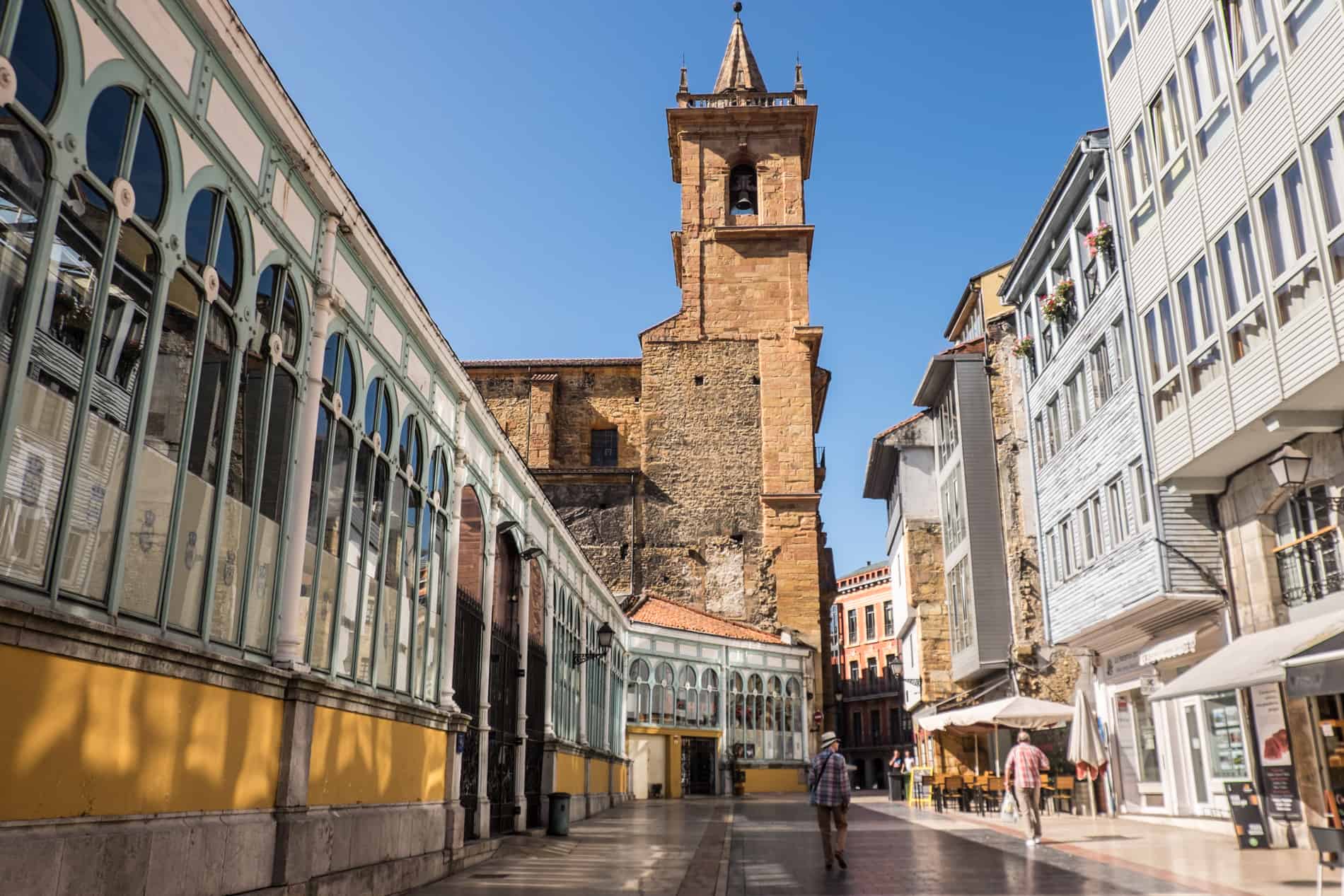
Mercado El Fontán is where you can shop for fresh Asturian food products.
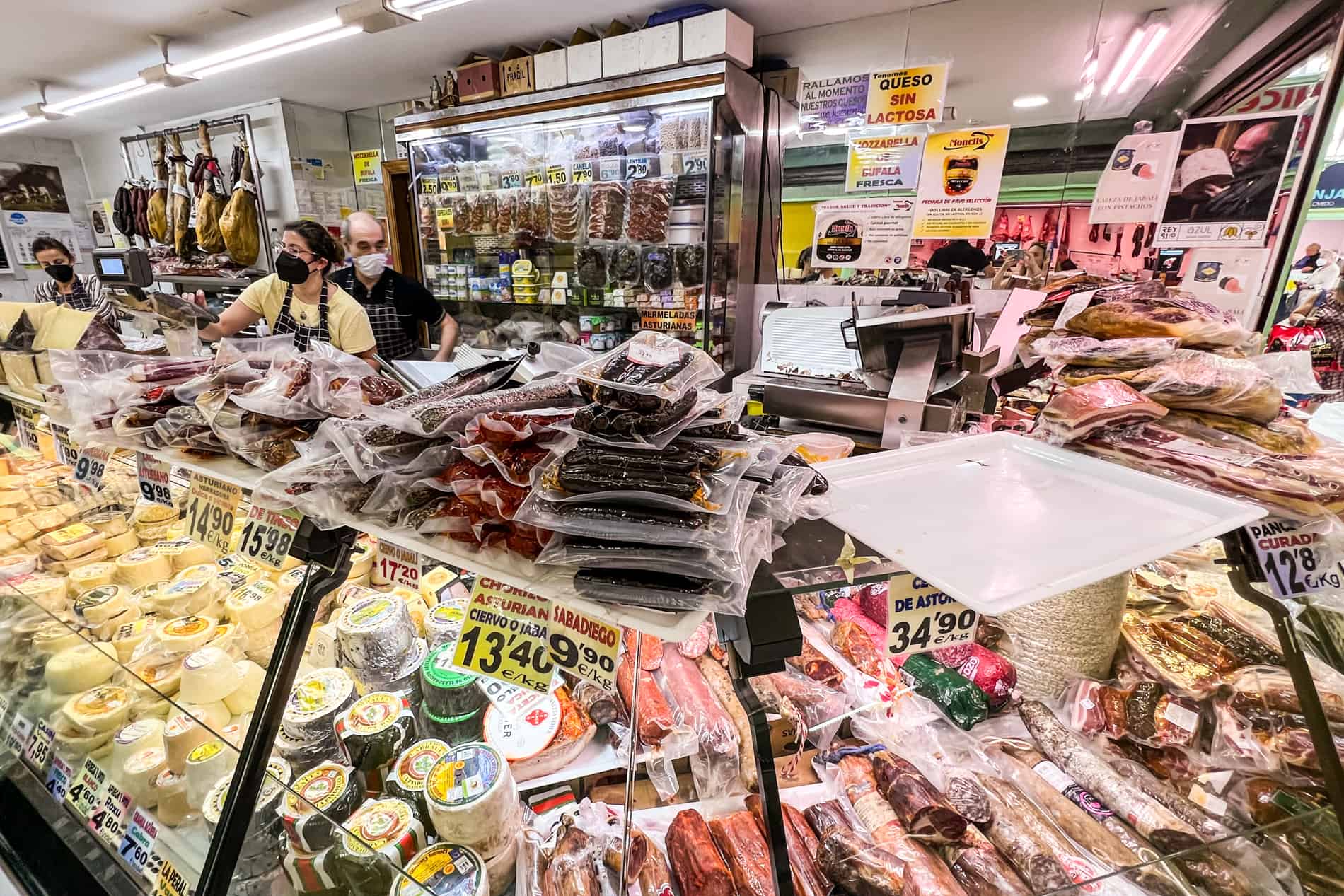
Mercado El Fontán is full of regional cheese and cured meats.
Try Asturian Dishes at Oviedo’s Top Restaurants
The holy trinity of Asturian dishes is Fabada Asturiana (fava bean and pork stew), Cachopo (layered veal, cheese, and ham in breadcrumbs), and Arroz con Leche (creamy rice pudding).
We sampled these in a three-course indulgence at one of the best restaurants in Oviedo, La Corte De Pelayo restaurant – champions of the Cachopo using a 1947 recipe. Gloria is another popular choice, run by Asturian chef, Nacho Manzano.
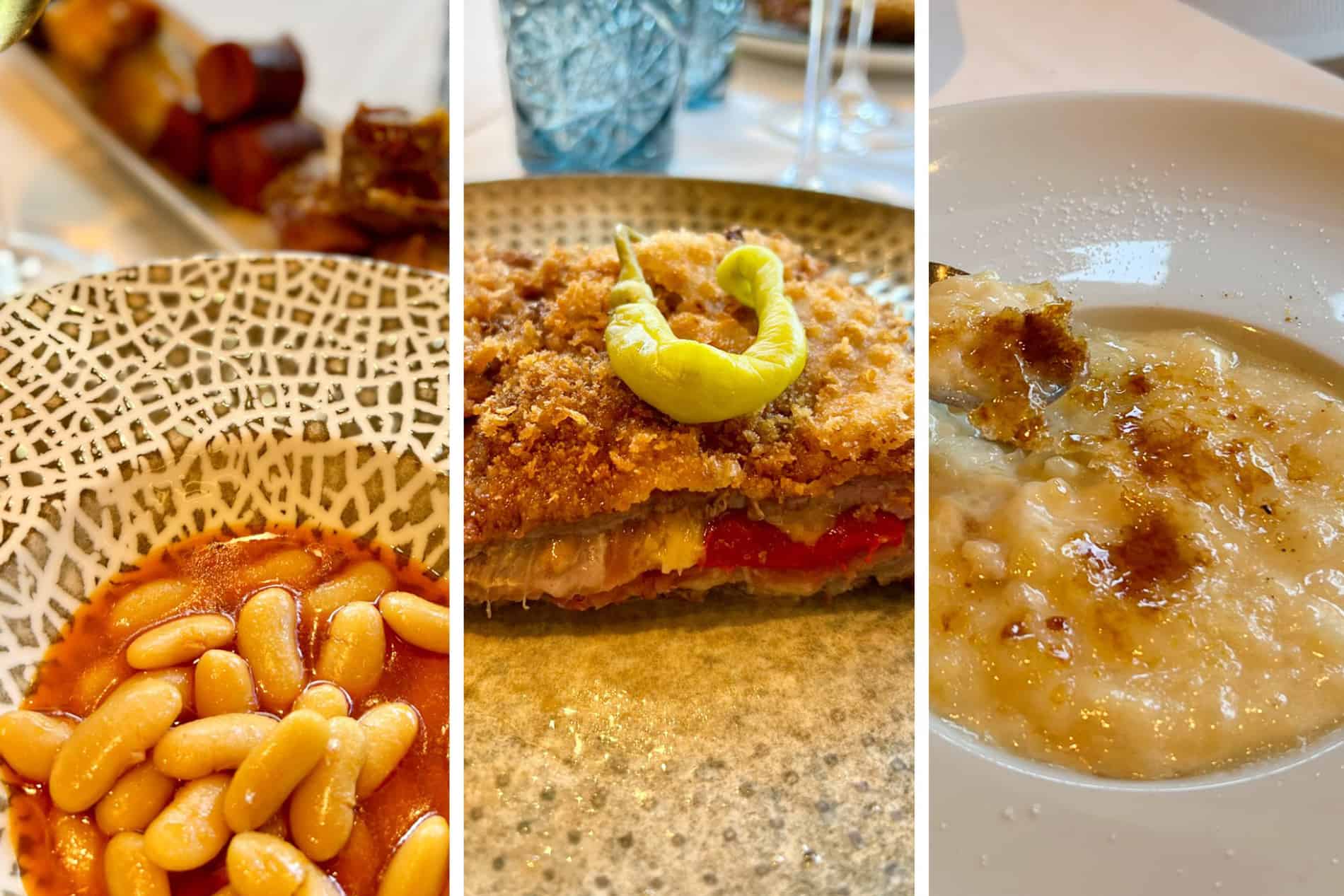
The famed Asturian dishes of Fabada Asturiana, Cachopo and Arroz con Leche.
Taste Artisan Asturian Cheese
Asturias is an artisan cheese paradise, with its prime mountain pastures and long-standing production traditions like cave maturation. So much so that Asturias is known as ‘El Pais de Los 40 Quesos’ (the land of 40 cheeses) and the most prominent cheese area in the European Union.
The strong, blue Cabrales cheese develops its intense taste during the cave maturation process (in the region of the same name). Gamonéu (made in Onís and Cangas de Oni) is like a softer, slightly saltier parmesan. Los Beyos is like a strong, creamy cheddar, and the orange Afuega’ l Pitu is close to feta, with a subtle tinge of spice.
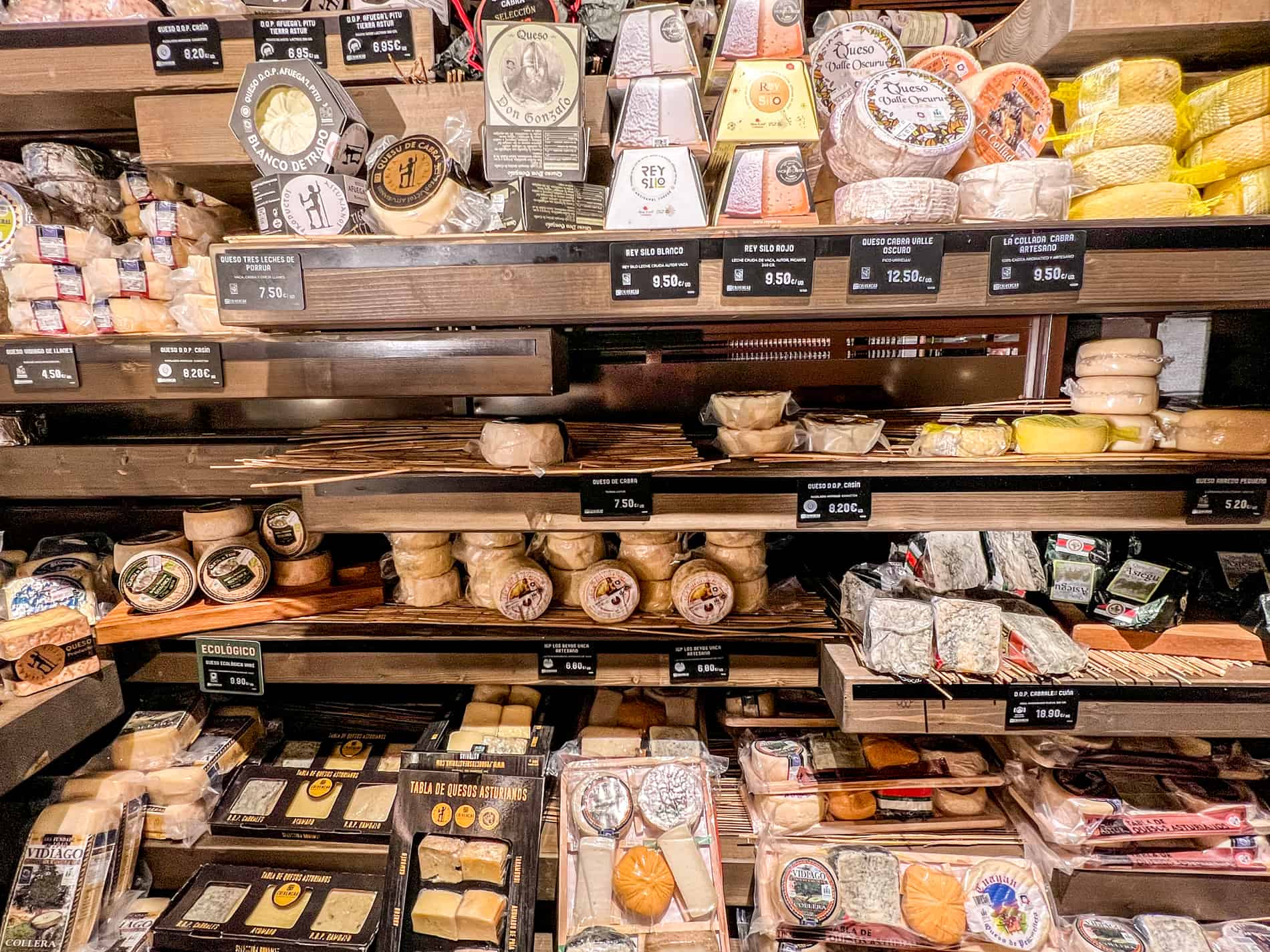
Asturias is known as ‘El Pais de Los 40 Quesos’ (the land of 40 cheeses).
Find the Master Confectioners
Head to Rialto for the best handmade confectionery in the city. The Carbayones (éclair-like pastries filled with almond and egg yolk and glazed with sugar) and Moscovitas (thin chocolate and almond biscuits) fill the window display to lure you in. Both have secret recipes, and they cite their products as having “a taste of happiness”, which I can confirm after devouring an entire box.
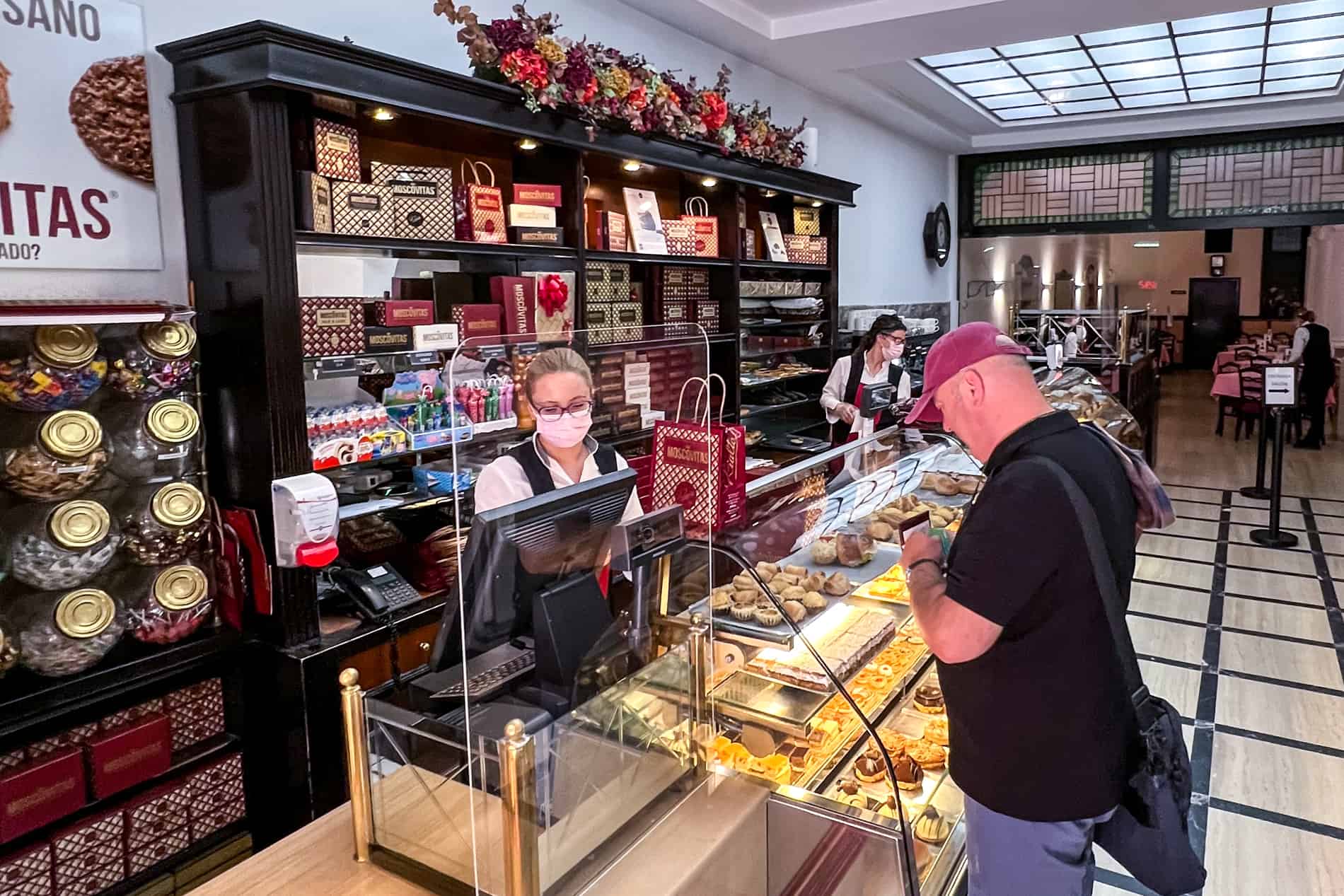
Inside Rialto, the best handmade confectionery in the city.
Visit a Sidrería and Enjoy Asturian Cider Culture
It’s near impossible to come to Oviedo and not visit a Sidrería (cider bar). Cider is a symbol of the region and is uniquely poured with pride. And while there’s a lot to choose from with the “Sidrerías de Asturias” quality seal, Cascona Street is where you’ll find around a dozen of them – its nicknamed “Cider Boulevard” for that reason.
One of the best is Tierra Astur, a funky space with wooden seating in the shape of barrels and fresh bottles of cider submerged in cool water pools.

One of the tastiest things to do in Oviedo is to visit the Tierra Astur Sidrería.

Thousands of green glass coder bottles hang from the interior of the Tierra Astur cider bar in Oviedo.
When at a Sidrería, you typically enjoy cheese tasting and tapas alongside small fresh pours of chilled cider. An Escanciador (cider pourer) will demonstrate the perfect Culete (small pour), which flows from a height to create bubbles for a hint of fizz, best enjoyed immediately in a single gulp.

The unique demonstration of the perfect small pour of Asturian cider.
Visit the Wine Route – ‘Ruta de Los Vinos’
Asturias isn’t known as a prominent wine-producing region, but it does have Cangas – the only wine appellation in the area, from its terraced mountain vineyards.
Campoamor, Manuel Pedregal, Frey Ceferino, and Avenue de Santander form a block of streets known as ‘Ruta de Los Vinos’ (Route of the wines). It showcases over ten wine and tapas bars, where you can sample Asturian vino and varieties from neighbouring regions.
Trips From Oviedo
Is Oviedo your starting point? Here are some ideas on what else to see in Asturias if you have some extra days.
What is Asturias Known For?
Oviedo, Avilés and Gijón are the largest urban areas in a region blanketed by green pastures and verdant valleys and cradled by the Picos de Europa mountains and the Cantabrian sea.
More than a third of Asturias’ landmass is declared protected areas, which is why the region labels itself a Natural Paradise. A city with access to nature, Oviedo – the most southern of the Asturian cities – is a good starting point from which to access some of the UNESCO-listed Biosphere Reserves, nature reserves, national monuments, and protected landscapes. Most notably, the Picos de Europa National Park to the west that’s famed for its high peaks, glacial lakes, and accessible hiking trails.
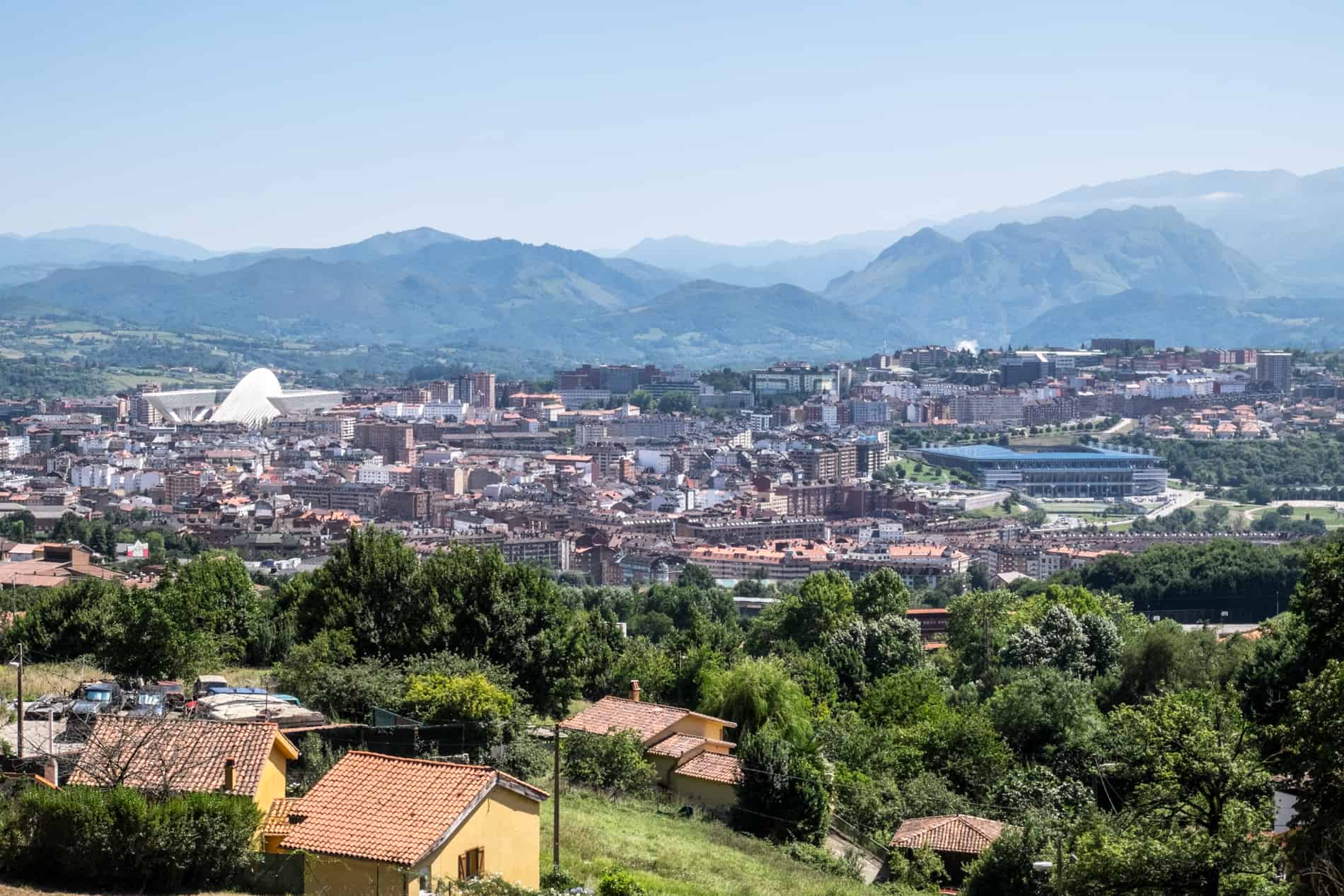
Mountain backed Oviedo – a city surrounded by nature.
Day Trip to Gijón for Coastal Time
Gijón is a charming city by the Cantabrian sea. Walk along Muro de San Lorenzo for sandy coastline and artistic sculptures on the western peninsula split by the Río Piles (River Piles), including the Monumento a la Madre del Emigrante.

The coastline and old town of Gijón.
The centre is in two parts. First, check out Centro – with its Modernist (Art Nouveau) style architecture when the city grew as a commercial centre in the late 19th century. Some of the best examples are along the main street of Calle Corrida, such as Jovellanos Theatre and connecting café Dindurra. The other area is Cimadevilla – the oldest area of the city – where you can wander amongst the remains of the Roman settlement of Gigia and see the ruins of the Roman Baths and step through the colourful historic neighbourhoods that have been home to fishermen, craftsmen, and the military.
Don’t miss the view from Santa Catalina Hill on the old town’s peninsula tip. Its landmark is the Elogio del Horizonte sculpture perched on the highest point. It was designed by Spanish artist Eduardo Chillida to amplify the sounds of the sea (it’s also affectionately known as King Kong’s Toilet).
Day Trip to Avilés
Complete your trip around all three Asturian cities with a trip to Avilés – a city that blends its medieval past and modern industrial heritage. Wander through the winding streets that take you past dozens of preserved medieval monuments, including churches, palaces, and merchant homes. Cross the Ría de Avilés (Aviles River) to the Modernist and futuristic structure of the Oscar Niemeyer International Cultural Centre – a juxtaposition to the old stone urban centre.
Go Hiking in the Picos de Europa National Park
There’s plenty of nature to be found in Asturian villages and small towns, but the region is also home to a vast chunk of Spain’s first national park – Picos de Europa National Park. Alfonso XII declared the then named Montaña de Covadonga a national Park in 1918.
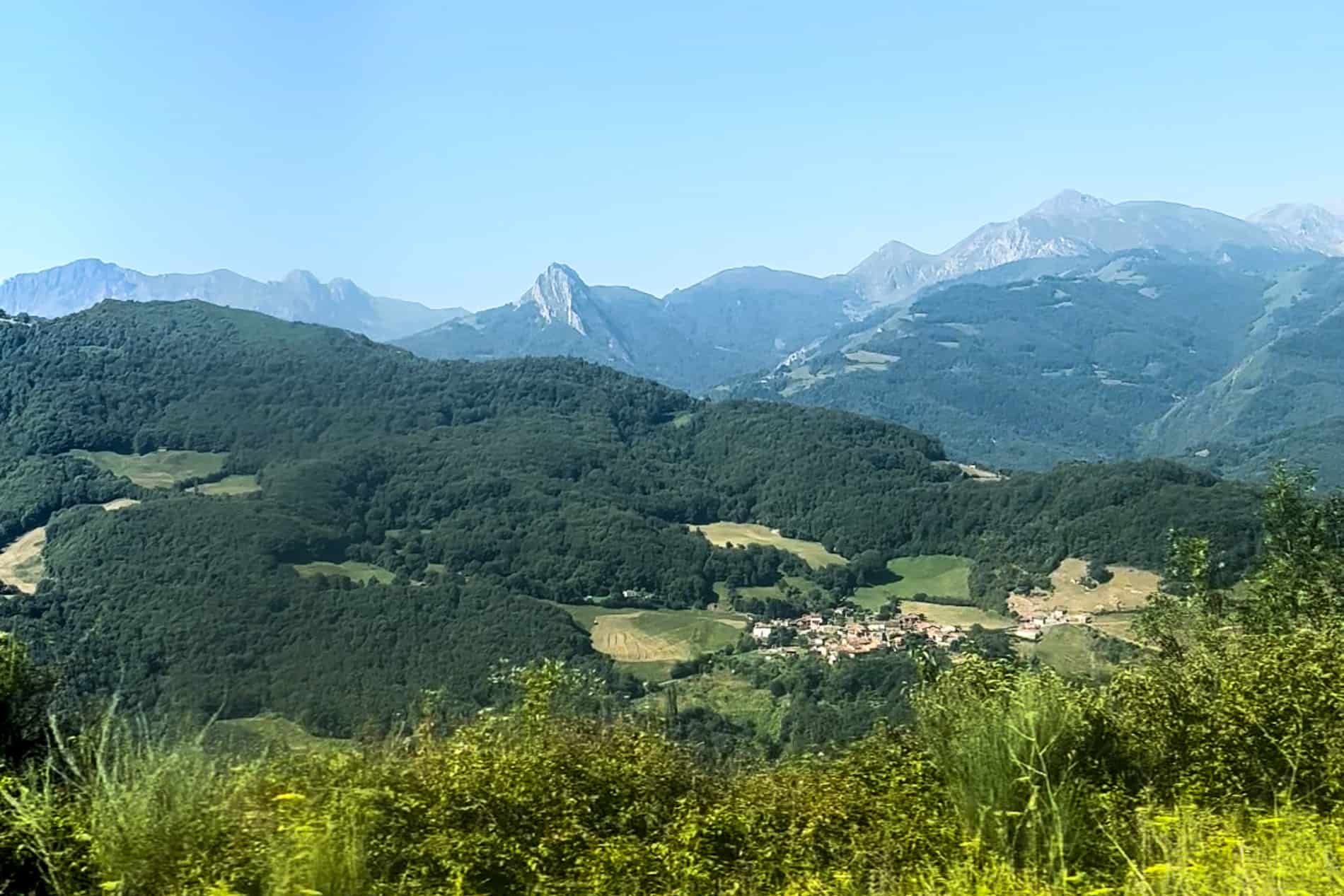
The mountainous terrain of Picos de Europa National Park in Asturias.
If you want to visit and pick up a hiking trail, the Asturian entrance to the park is in Cangas de Onís, not far from the two glacial Lakes of Covadonga. Venture further for access to the hiking trail of the Ruta del Cares (a 12-km gorge route) and the Ruta del Alba (a 7-km trail on a former shepherd’s path that runs parallel to the Alba river).
You can also hike to the base of Picu Urriellu (Naranjo de Bulnes) – the highest peak in the Asturian section of the park, at 2,519 metres. The highest peak in Picos de Europa is Torre de Cerredo – but its 2,650-metre summit is technically in the neighbouring province of Castilla y León.
My deep dive into the Asturias capital was part of a trip exploring all the places to visit and things to do in Northern Spain by train, in partnership with Spanish Tourism. Thoughts, insights and opinions remain my own.


Clive Dixon says
What an elegant and delighful city. A half day visit was nowhere near enough but we shall return, sophisticated, atmospheric and spotless, not to be missed.
Tim says
I absolutely loved this insightful story about Oviedo in Asturias. There is something magical about this place, and it feels like a hidden treasure.
Becki says
It really is a city in Spain that deserves more attention – it’s beautiful!